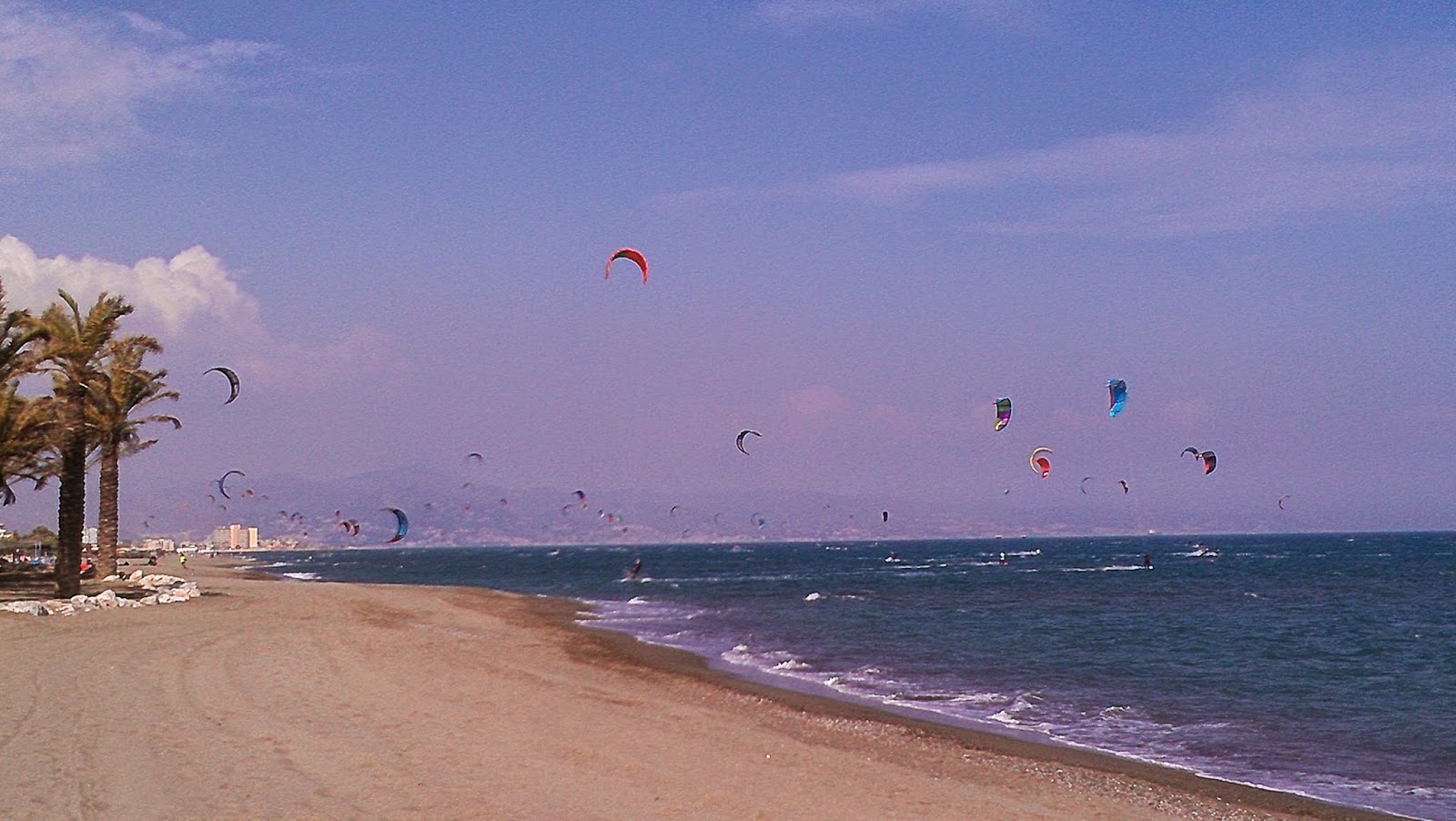spanish word of the day: abrigar
Abrigar. (verb) To bundle up. To protect oneself from the cold.
As I was leaving the apartment with my bike, I ran into my elderly neighbor, Sr. Braulio.
"Vas en bici?" He asked, looking a little dubious. (Are you going by bike?)
"Siiii," I replied. Then followed with, "Tengo mis guantes, mi bufonda..." (I got my gloves, my scarf...)
"Ahh..." He responded. "Hay que abrigar!"(Ya gotta bundle up!)
estoy harta (i'm fed up)
Living in a small Spanish town is hard. Harder than I thought. I can’t believe it’s been 4 months, and I still struggle with being here.
Still
. I mean, I’m usually a pretty adaptable person, so I’m kind of shocked that I haven’t successfully done so here. I feel like almost every moment is a struggle. Nothing comes easily. Nothing is without a little bit of pain, inconvenience, or the unexpected element of surprise. I feel like I’ve been being (or trying to be) mentally and physically tough the entire time I’ve been here. And I don’t think I want to keep it up anymore. Or at least… I need to take a break from this sh*t.

***
Today, I left the bike behind at the house and walked to school instead. I got to school about 30 minutes late for my first class. I had no excuse other than, I couldn’t make it. That’s it. For my evening class, I showed up about 5 minutes late, and I flat out told the teacher – I’m totally unprepared today. She told me to go home. I did. This is what I call radical self-care tinged with a little bit of, ‘Yo. Eff this sh*t’.
***
Living alone was probably not the best decision after all, so I’ve started looking for a new apartment – with roommates. I spent time at the instituto this morning contacting the few shared apartments I found online last night. This evening, they both called back. I’ll be going to take a look at them tomorrow. Hopefully, at least one of them will feel like a better situation than I’m in right now. God, I hope so. I really need an improvement – just for my state of mind. I’m starting to feel so mentally worn down and raw-edged. Like, anything could make me cry these days. What kinda thug cries at the drop of a hat?
***
I watched two movies this weekend about folks locked down in solitary confinement. One was a movie with Kevin Bacon (who did his thing in the role, I might add) as a petty criminal who’d been in solitary in Alcatraz for 3 years in the 1930s. The other was the biopic about Ruben Hurricane Carter starring Denzel. Both felt like my life right now. Mumbling to myself, laughing to myself, entertaining myself with my own vivid daydreams and imaginings. Plus, something that Denzel-as-Ruben said in the movie really stuck with me. I just gotta focus on doing the time. Not on when I’ll get out, not on what my life used to be like in some other place. Just doing the time.
So far, I’ve done 4 months. I’d been thinking that I had 5 more months to go, and that there was no way in hell or on God’s green earth that I could possibly do another 5 months like this. But, then, all of a sudden I realized that the end of May is only a little more than 3 months away (I did start the program late, after all). 90 days doesn’t seem nearly as bad as 5 months. Maybe I can make it. Maybe.
***
I’m tired of fighting the cold
I’m tired of fighting the bike
I’m tired of fighting my schedule
I’m tired of fighting my shower

I’m tired of fighting my coffee maker
I’m tired of fighting my bed
I’m tired of the internet being so damned slow. Slow? No. slow would be an improvement
I’m tired of not having a DVD player
I’m tired of watching the same damned TV shows every damned day
I’m tired of the same crappy movies on Paramount channel
I’m tired of the cold
I’m tired of being sick
I’m sick of waiting a week for my clothes to dry
I’m sick of not having any clothes to wear
I’m sick of going shopping for clothes only to realize that I’m not made like a Spanish woman. (Yes, this dress is very nice. But
where
do my boobs go?)
I’m sick of going to the library
I’m sick of going to my evening class
I’m sick of this town
No. I’m
over
this town
I’m over these people who live here and the way they walk (Seriously? Can you f*ckin’
move
, please?)
I’m over my students acting like slack-jawed yokels some days (What’s
up
with that?
Think
, dammit!)
I’m over this cold
I’m over this sh*tty ass food. Like, really, can I get
one
decent restaurant that either doesn’t have the same tired ass tapas that EVERY other restaurant has, OR isn’t ridiculously overpriced!? The f*ck?
I’m over positive self-talk. I’m over trying to convince myself that I can
do
this, that I
got
this, that I can make it if I just
try
. No. Enough of that. Today, it’s just me, my screwface, and hip-hop blaring through my headphones as I stomp-walk through the streets of Ciudad Real.
I can try again… tomorrow.
****** UPDATE; Since I first penned these thoughts almost a month ago, things have changed considerably. That apartment and those roommates I was hunting for? Found 'em. I now live with 3 other ladies of varying ages. It feels nice to no longer have only myself to talk to, and to have other living, breathing humans to share the details of my day with. I've even made some connections with other Americans living in town, and we meet fairly regularly to share tapas, drinks, laughter, and stories of expat life.
That cold that I was so very sick of? The new apartment has much better heating, and the seemingly neverending winter in my little Spanish town has magically transformed into spring - almost overnight. This means that I've been able to reunite with my rusty old bike that one of my coworkers loaned me. Now that I no longer have to abrigarme every day, I can actually enjoy the sometimes-challenging ride through town on my way to school or to run errands. I even catch myself humming or singing little tunes as I pedal through the streets - a much better use of my vocal chords than the under-my-breath curses that I used to emit.
That terrible Internet connection that forced me to go to use the wifi at the public library, where I was often prey for creepy library stalkers... it is no more. The wifi in my new place is about as strong as it gets. So, not only can I get more writing work done in the comfort of my own room, I can also watch a variety of TV programs and movies that just weren't available to me before. And sometimes, when I am just sitting in my room, enjoying the relative softness of my new bed, or watching the sunlight stream in through the window, I hear the lilting sounds of my neighbor practicing the flute (thankfully, he or she is pretty damned good!) or the bells from the nearby cathedral chiming the hour... and I smile, and say a little prayer of thanks.
Through all of this, I've realized (or been reminded) that making a mid-course correction isn't the same as failing; that suffering isn't necessary, that when going through something that you know is making you stronger and more resilient, you still have the right and the power to say when you've reached your limit.
And that sometimes, 'eff this sh*t', is exactly the right answer.

A little reminder I wrote to myself and kept on my bedside table when I decided to stop struggling.
useful auxiliar tip: the 15-minute back pocket exercise
Keep a back-pocket full of 15-minute activities, exercises or simple games that you can whip out at a moment’s notice. It should be something that is suitable or easily adaptable for all levels, and doesn’t need any special materials or equipment. Invariably, you will find yourself in a situation where the teacher has deserted you or you have extra time on your hands at the end of a previous activity. I call them 'gaping hole' moments. You don’t want gaping hole moments. A few of my favorite 15-minute activities:
, Jeopardy!, conversation cards, and a little game I like to call 'Say It, Spell It, Count It'. With this game, I write different words, numbers, or simple math problems on slips of paper. Each student takes turn pulling a slip of paper from the bag. They have to either say the word in English (it's written in Spanish on the paper), Spell the word in English (also written in Spanish on the paper), or count something (i.e., say a number or give the answer to a simple problem).
What sort of 'gaping hole' activities do you use with your classes and private lessons?

tapa of the week: bar el alcazar, ciudad real
I passed the place at least a handful of times over a few weeks before I finally went in. It was always packed. People inside at the bar. People outside at the walk-up window. More people inside on the little perches on the opposite side of the bar.
I knew that was probably a good sign, but... I just didn't have the nerve to bust up into a narrow, packed bar and be met with open stares of confusion and curiosity. I just wanted a snack. And a beer.
Then one day, I happened to be walking past the place with a Spanish-speaking friend, and I suggested we pop in and check it out.
"Dan comida aqui?" My friend asked of the bartender, who was propped up just inside the walk-up window.
In a gruff voice, the bartender replied, "Aqui damos todo excepto dinero!" eliciting a round of laughter from the bunch of patrons gathered outside,
Bar El Alcazar has a better selection of tapas than most of the other bars in Ciudad Real. There's a wide variety, and the portions are hearty for tapas. My first time out, I really didn't know what many of the things on the menu were, so I just selected something that I thought sounded good: rejos. My friend opted for huevo roto con gulas.
Here's what showed up:

Rejos - or fried octopus tentacles - along with fries

Huevo roto ('up' egg) with gulas (imitation baby eels), served along with fries
The food was perfect. I'm a lover of any kind of fried seafood, so the rejos were right up my alley. I tasted my friend's gulas, and even though the look of them kind of freaked me out, the salty taste with the creamy, runny yolk was right. So right.
Since that day, I've become almost a regular at El Alcazar. I even refer to it as 'my bar'. The gruff bartender? Knows my order before I ask for it now. And though sometimes the quality varies, I still end up there fairly often.
Bar El Alcazar
Calle de Palma, 12, Ciudad Real, Spain 13004
Average Price per Tapa: Free tapa with drink. Drinks range from 1.60 (beer) to 1.80 euro (wine).
My Rating: One of the most popular tapas bars in Ciudad Real for good reason. Repeat visits encouraged.
spanish word of the day: caber
Caber (verb) - to fit, to have room for.
As is my usual habit on Thursdays, I go have a coffee and a churrito in the cafeteria at school after my first and only class of the day. Today, the churritos weren't yet ready when I arrived and ordered my coffee. The guy who runs the cafeteria set out a mini muffin for me to eat while the churritos finished cooking.
"Oh, no..." I protested, "Yo puedo esperar por el churrito." (I can wait for the churrito.)
"Tu eres grande," he replied. "Te cabe!" (You're big. You have room for it!)
Sir!!
how to do valencia
What better thing to do on a long holiday weekend than visit and explore a new city? Desperate to escape the chilly early December weather of Spain's interior, I settled on Valencia. I'd already had a brief, enjoyable visit to the Costa Blanca, and I'd heard good things about the bigger city to the north. Without much of an itinerary at all, I set off on a Thursday for a 4-day excursion to Valencia.
How to Do Valencia: Stay With a Great AirBnB Host
No guide book or self-researched travel itinerary beats the hands-on help of a capable and compatible host. Luckily, I found both in Guillermo, my AirBnB host in Valencia. Not only did he meet me at the train station on arrival, he was kind enough to share his lunch with me after showing me the way to his flat.

Home-cooked lunch at Guillermo's
As we chatted over lunch, I learned that Guillermo was a native of El Salvador, and was studying urban planning and development. He'd lived off and on in Valencia for 16 years, so I knew he was well qualified to give me some good advice on what to see and do around town.

Guillermo's surprised face when he's not expecting to be photographed.
Before I headed out to do some exploring on my own, Guillermo provided me a selection of maps to use during my stay, and quickly gave me the lay of the land.
Where I Stayed: AirBnB Private Room in Ruzafa, Valencia
How to Do Valencia: See the Sights in Ciutat Vella (Old Town)
After resting up a bit, I decided to head out and walk around the historic area of Valencia, otherwise known as Ciutat Vella. Despite Guillermo's map and explaining, I managed to get a little turned around during my stroll, but still found my way to the following points of interest.

Porta de la Mar - at the eastern end of Ciutat Vella

Christmas lights and shopping on Carrer del Pau

The Valencia Cathedral, or, the Metrpolitan Cathedral-Basilica of the Assumption of Our Lady of Valencia

Torres de Serranos at the northern end of Ciutat Vella, El Carmen

Torres de Serranos - front view

Christmas lights at the Plaza del Ayuntamiento in Valencia

Plaza de Toros, Valencia
Sights to See in Ciutat Vella, Valencia (Spanish)
How to Do Valencia: Wander Around the Ruzafa Market
Saturday morning on a holiday weekend. I wake up early-ish, and the only thing on my mind is, "Gawd, I hope the market is open." As I mentioned in an
, visiting the local market is one of my favorite ways to get a sense of the culture and flavor of a Spanish city. The Ruzafa market was a treat, and I spent at least an hour strolling through, peering at the fresh items on offer at each of the stalls, and trying to stay out of the way of the old folks who were out early getting their shopping done before the official start of the holiday. I was even able to try a few free samples - 1 was of some amazing roasted pumpkins (I bought a half to take home for a snack later), and the other was of a really nice cava on sale at a wine shop in the market. Guillermo joined me at the market later and showed me to a coffee shop in the market that serves coffee for free (tips accepted) - since they make their money on bulk sales of beans. A great way to start the day!




Free samples of cava? Why yes, thank you.


roasted pumpkins - you get to try before you buy

How to Do Valencia: Taste Authentic Argentinian Italian Pizza
I had no idea that there was a significant Italian community in Argentina, but I found out when I visited La Nonna - an Argentinian Italian restaurant in Valencia. The owners hail from Argentina, and the restaurant's menu boasts a mouth-watering selection of brick-oven Italian pizzas along with some Argentinian steak and meat dishes.
The pizzas are top notch - crispy but tender crust, fresh topping, and the gooiest of cheeses. La Nonna features a daily menu that allows you to select a salad or small plate as a first course, your choice of pizza, along with drink and a dessert for about 12euro.

Carpaccio de pulpo - La Nonna
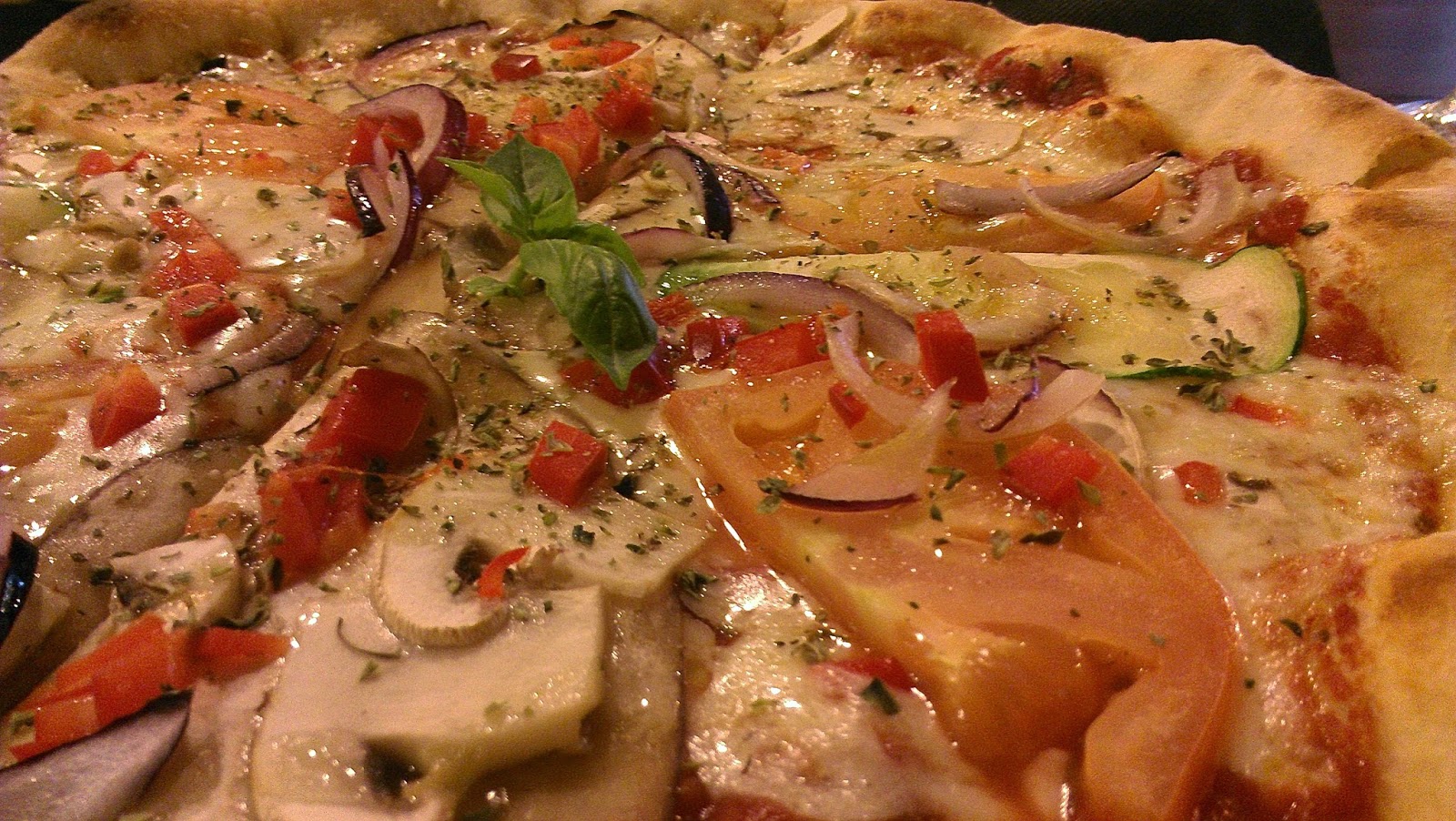
Veggie pizza at La Nonna
La Nonna Calle Puerto Rico, 16 Valencia, Spain
How to Do Valencia: Hang with the Hipster Set at Calypso
We enter the smallish bar and order a couple of beers. As my eyes adjust to the darkness, I wonder not only where I am, but
when
. The music is a non-stop selection of 60s surfer and ska tunes .The DJ, who for some unexplicable reason is wearing a Mexcan luchador mask, seems thrilled to be providing the ambience for the evening. He bobs his head and does a little funky two step to the music. I scan the rest of the room, taking in the scene. The decor is best described as retro tiki chic. Overhead, a tiny tv is showing original versions of the Super Friends cartoon. I am the only one paying it any attention, however. The rest of the steadily swelling crowd at Calypso presents varying shades of hipster as they chat and sip their drinks. Skinny jeans, wallet chains, lumberjack shirts, carefully ungroomed beards, blunt-cut bangs, cat eye glasses, red-as-red-can-be lipstick... all the expected accoutrements are there. Well, all except one. There's a total lack of irony among the patrons, instead there's an easy, genuine feeling of 'hey, we're just here to have a good time, not to pose and look cute.' As I approach the bar for my second round, the bartender holds up a vintage camera and captures me with a flash. The luchador-DJ points and nods his approval.



Calypso Russafa Carlos Cervera, 9 Valencia, Spain
How to Do Valencia: Have Sunday Paella with a Valencian Nationalist
Guillermo invites me out to have
beers with him and his friend, Vicént. “He’s very nationalist,” Guillermo warns. I’m not sure I like the sound of that. “What exactly,” I cautiously begin, “do you mean by ‘nationalist’?” “Well, he only speaks Valenciano. When a Spanish team is playing a football match, he roots for the other team. When he tells people where he’s from, he doesn’t say I’m Spanish, he says, I’m Valencian. If he could, he’d prefer that his passport said that, but since he can’t change it, he’s stuck with it saying he’s from Spain. But don’t worry, he likes to practice his English.” Well, I think. This should be… fun. As it turns out, Guillermo was exaggerating a bit. Or, maybe Vicént was on his best behavior. Throughout the night we shift as easily between English, Castellano, and Valenciano (them, not me) as we do from 1 bar to the next. At the second bar, after Vicént explains to me over the loud music that he lives in a neighborhood not far from the beach, I jokingly quip, “Oh, so you’re going to make a paella for us tomorrow?” As Guillermo had hipped me earlier, paella is typically eaten by Valencians for Sunday lunch, often just before or after a relaxing stroll along the Mediterranean. To my surprise, Vicént replies with barely a pause, “Yes! You should both come over around 3!” Wait. What? Guillermo had already offered to show me to a restaurant serving authentic paella that would be much better and cheaper than the touristy options along the beach. But, this? This was more than I could have expected. I turned to share the change in plans to Guillermo. His face instantly registered his shock. “Wow. That was fast!” he says

Vicent prepares what he says is not truly paella, but octopus rice. Guillermo supervises, beer at the ready.

Shared salad to accompany the main course

Vicent's 'octopus rice'

"This right here? Is how you do pumpkin," says Vicent.

All smiles! An after-lunch coffee at the cafe on the corner
How to Do Valencia: Take a Stroll Through El Cabanyal
After lunch, Vicént offers to show us around El Cabanyal – the neighborhood he grew up in and the same neighborhood his family lived in for several generations. “It used to feel like a little village,” he says. Originally a working class neighborhood of fisherman and port workers, it’s now plagued by urban blight. Kids play in the street right across from the older boys hanging out in front of the corner store. The older ones don’t go inside to buy anything. They stay outside all day to sell.


Vicént stops at regular intervals to point out one crumbling, dilapidated building after another. “My grandmother was born there. We used to go pick up huge chunks of ice over there. My uncle’s house was here. My first job was washing cars in that place over there.” I can feel the mix of wistfulness and pride in his voice.


Guillermo and Vicént share that the state of the neighborhood is an intentional move on the part of the local government. They want to expand a nearby avenue so that it connects with the beach further to the south – El Cabanyal is right in the path of this proposed throughway.
We leave El Cabanyal and stroll along the beach, catch a batucada group practicing their moves, watch the sun set over the waves. After our walk, Guillermo and I bid Vicént thanks and goodbye, and catch the metro back home.


How to Do Valencia: Have a Farewell Dinner for a New Friend
My first night in Valencia, while Guillermo and I were grabbing some eats in a nearby Cuban restaurant, I met Tanya. Tany
a was a native of Brooklyn, and was currently living and teaching English in Madrid. We all chatted cordially, and I invited Tanya to join Guillermo and I for bar-hopping after dinner. Tanya shared that she’d only just decided to come to Valencia for the holiday weekend last night. She was an experienced solo traveler, and could easily enjoy exploring a city on her own or with newly made friends wherever she happened to find them. Of course, we hit it off instantly. We exchanged contact info at the end of the night and hung out again for several hours the next day.
On Tanya’s last night in Valencia, we met up for a Moroccan dinner at Restaurant Zakaria. I'd read online about one of their more popular dishes, Cordero con ciruelas (Lamb with prunes), and decided to order it. Tanya ordered a couscous dish and we shared. While both dishes were delicious, the lamb dish was certainly more memorable. Sweet, smoky caramelized onions, well-spiced lamb, and tender prunes made for a warm, comforting blend of flavors - perfect for the slightly chilly evening weather. Portions and prices were quite good at Restaurant Zakaria. A must-visit if you like North African cuisine.


Cordero con ciruelas at Restaurant Zakaria

Chicken and vegetable couscous at Restaurant Zakaria
Our after-dinner plan to find a bar or club with some cool tunes was mostly a bust and ended up with Tanya and me going on a Google search-inspired wild goose chase around the city center that lasted ‘til the wee hours of the morning. But, in the end, it was all good. We had just as much fun getting lost, people watching, laughing like giddy teenagers, and even singing the hooks of old funk and soul tunes on the streets of Valencia. Sometimes it’s not so much about where you’re going, but who you’re travelling with.

Tanya and I outside of Havana, the Cuban restaurant where we met in Valencia
Carrer de Puerto Rico, 26, Valencia, Spain
How to Do Valencia: Head Down the River to the City of Arts & Sciences
On my last day in Valencia, I head out to explore the ‘river’, which is what the locals call the continuous band of recreational green space that snakes through most of the city. Many decades ago, it was an actual river, but after repeated floods, it was drained and turned into a park. The weather is as perfect as it can be, and there are tons of people enjoying the day – running, strolling, biking, or just soaking up the sun.



At the south end of the river, I encounter the City of Arts and Sciences, a complex of museum buildings, each one dedicated to a specific area of scientific discovery and exploration. For the sake of time, I opt not to go inside of the museums. The buildings themselves are breathtaking works of art. The combination of futuristic architecture, glittering water features, and the shifting light of the sun makes for a unique visual feast. I take far too many pictures as I walk.







How to Do Valencia: Watch a Revolutionary Screening at Recordshop
When I return to Guillermo's, he asks if I’d be up for seeing a free documentary screening at a nearby bar this evening. “Sure. Which documentary?” I query. He shows me the flyer on his computer. I nearly squeal with excitement. Turns out it’s Wattstax. I’ve been wanting to see it for years, but have never gotten around to it. I’m thrilled to have the opportunity now. We head out a little while later to Recordshop, which is part bar, part ‘cultural association’ with lots of vinyl on display. The owner regularly screens films in the space that is about as big as a large living room. Before the movie, the owner plays Jimi Hendrix’s ‘Axis: Bold as Love’ album (on an actual record player), while Guillermo and I sip beers. Soon, the movie begins. I settle into a worn couch and immerse myself in the sounds of a soulful revolution.


Recordshop Cultural Association Calle Sevilla, 31 Valencia, Spain
How to Do Valencia: Savor Handcrafted Burgers at Slaughterhouse
For my last meal in Valencia, Guillermo and I head to Slaughterhouse, a popular burger restaurant that actually was a slaughterhouse in a previous incarnation. We’d walked past the place on my first night in town, and the smell wafting out onto the street had instantly grabbed my stomach by the nose. Online reviews and Guillermo's own personal recommendation confirmed that this place made some really tasty burgers, so I was glad to have a chance to sample one before heading home. Each of the burgers on the menu at Slaughterhouse gets its name from a fillm or book that is also listed as a recommendation on the menu. All the ingredients on the burgers are fresh and/or homemade, all the way down to the ketchup.I don't always eat burgers back in the States, but when I do, I want it to be a damned good burger. Here in Spain, I've tried burgers a few times, but they've always been 'off' somehow, falling short of my expectations for a well-prepared, proper tasting burger. Thankfully, I found redemption at Slaughterhouse. The Movska burger that I ordered was everything I'd been missing from home. By this time, I wasn't even surprised. After all, in just a few days in Valencia, I had already found so much that made feel right at home.

Slaughterhouse menu

The Movska burger at Slaughterhouse

A disco ball and a meathook - part of the eclectic decor at Slaughterhouse
SlaughterhouseCarrer de Dénia, 22Valencia, Spain
How I Got There: AVE High Speed Train (Spain Pass)
I'm a heavy user of Spain's discount railway pass for non-Spanish travelers. It's called Spain Pass, and I've used it several times to visit cities that are far enough away for me to want to avoid a bus ride (my bus limit is about 3 hours). The trip to Valencia from Ciudad Real took a little over 2 hours on the high-speed train. The same trip would by bus would take about 6 hours, and cost about the same.

Have you had a chance to visit Valencia yet? Share your favorite finds in the comments!
how do you say 'mercury retrograde' in spanish?
My First Big Mistake
My Second Big Mistake
tapa of the week: bar acuario, ciudad real
After the so-so experience I had at Meson de Ocatvio, I decided to ditch the idea of following a tapas guide. I figured it would be better if I went maverick, trying out and recording notes on tapas bars I happened to encounter on my own.
 |
| huevo con bechamel at Bar Acuario, Ciudad Real |
Bar Acuario
Plaza Mayor, 11, Ciudad Real, Spain 13001
Average Price per Tapa: Free with drink. Drinks about 1.50 euro
My Rating: Solid. Worth a visit and worthy of being in regular rotation.
tapa of the week: meson de ocatvio, ciudad real
One day whilst sitting in my little apartment in my little town of Ciudad Real, bored as bored could be, I decided to take matters into my own hands. "What..." I asked myself, "...could I possibly do to keep myself entertained and inspired in this smallish city where I still haven't quite found my 'scene'?"
Before long, an idea struck. The weekend I'd arrived, there was a tapas festival, Tapearte, going on in Ciudad Real. Dozens of restaurants in the city were participating, and each restaurant had created a special tapa for the week of the festival. The idea was that residents and visitors could do a sort of 'ruta de tapas' by visiting all of the different participating restaurants and sampling their tapas. There was even a printed guide with a map of all the restaurants and their featured tapas that I'd snagged from the hotel I'd stayed in my first week. Unfortunately, since more pressing matters like finding an apartment and figuring out my school routine were higher priority at that time, I didn't get a chance to visit any of the restaurants, but I'd held on to the guide and map.
"Why not do your own personal ruta de tapas?" I thought to myelf. "You could visit all of the places on the guide and sample whatever they have on offer. It'd be a great way to get to know some new places while keeping your belly full."
Inspired by my idea, I whipped out the Tapearte guide, quickly perused the list to see which place sounded most appetizing, then decided it was best to just start at the beginning. And that's how I found myself at Meson de Octavio, the very first restaurant on the list.
When I walked into the restaurant / bar located just north of the Puerta de Toledo in Ciudad Real, there were only a few other people inside. I greeted the bartender and asked if there was anything to tapear. At first he acted as if I'd invented the word, Then after I'd explained that I'd found this place from looking at the Tapearte guide, he suggested a tapa of risotto. I figured if he knew what I was after, he'd recommend something good.
What I got was slightly undercooked, slightly oversalted rice in a creamy sauce with a little drizzle of oil.
I think the bartender saw by looking at my face that I wasn't exactly pleased with the dish, so he quickly recommended 3 other things. I opted for ternera (beef) en salsa.
Ah, that's more like it! The dish was simple, but the meat was very flavorful and very tender - like a really nice beef stew. It even went really well with the crunchy risotto.
Along with my caña, the two tapas came out to 3.60 euro. Not a bad deal. But not a great deal either, considering I wasn't pleased with my first selection. Ah well, there's always next time!
Meson de Octavio
Calle Severo Ochoa, 6, Ciudad Real, Spain 13005
Average Price per Tapa: 1.20 euro
My Rating: Meh. Probably not worth a second visit for tapas.
7 things you must see in every spanish city
1. Its cathedral
 |
| The Cathedral in Toledo |
 |
| Christopher Columbus' remains - inside Sevilla Cathedral |
| In Cordoba - the Cathedral is located inside of a mosque |
2. If it’s on a coast, its beach. If not, its Plaza Mayor
 |
| Waiting on fresh catch at a chiringuito at Malagueta beach |
 |
| Plaza Mayor in Ciudad Real at Christmas |
 |
| Picture-perfect view of Marbella's beach and Paseo Maritimo in winter |
3. Its most popular tapas bar or cervecería
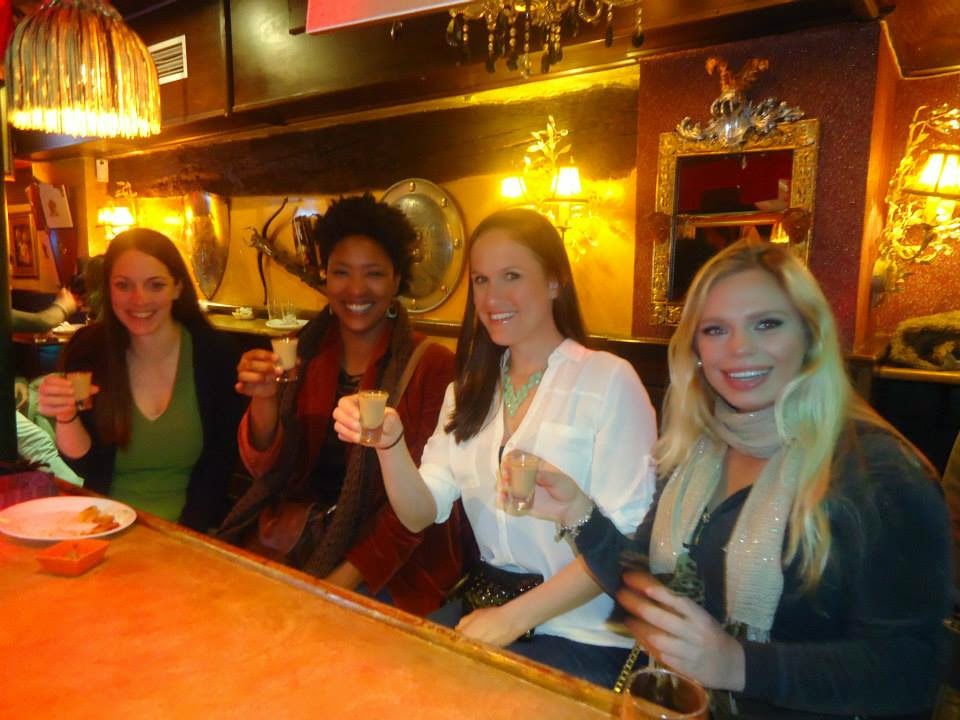 |
| Complimentary chupitos in Granada |
 |
| Ciudad Real's El Alcazar - always crowded, always good. |
 |
| At Malaga's Antigua Casa de Guardia, the waiters chalk up your tab on the bar. |
4. Its ethnic neighborhood
 |
| At Baobab, a Senegalese restaurant in the Lavapies neighborhood of Madrid |
 |
| In Valencia's vibrant Ruzafa 'hood, new restaurants seem to pop up every day. |
 |
| At A Tu Bola, in Barcelona's Raval district, fusion albondigas are on the menu. |
5. Its municipal market
 |
| Atarazanas Market, Malaga |
 |
| The central market in Cadiz is a bustling bar scene at night. |
6. Its Casco Antiguo
 |
| The most breathtaking views in Ronda are found in its old town |
 |
| Even in modern Marbella, there's a charming casco antiguo to get lost in. |
7. Its lesser known park
 |
| Ciudad Real's Parque del Pilar |
 |
| Jardin el Capricho - Madrid's other park |
livin' la vida monja
espere tu turno, gracias.
 |
| Emilio. Waits for no one. |
toto, we’re not in marbella anymore
Adjusting to a new place can be hard. And, though the process has only just begun for me, I think that adjusting to Ciudad Real will definitely present some challenges, mainly because I can’t help but compare it to my stint in Marbella. So far, there have been a few things that have stood out as being distinctly different than my previous experience living in Spain. Not all of them are bad differences, but they’re certainly noticeable. Here are a few:
- They don’t speak Spanish here. I found out this little fact when one of the teachers at my school complimented me on my speaking. To my surprise, she didn’t say, “Hablas español muy bien,” instead I got, “Hablas castellano muy bien.” In my head, I gave her the ‘whatchoo talkin’ ‘bout Willis?’ face, but on the outside, I kindly thanked her and went on with our conversation. Of course, castellano and español are exactly the same thing, but since we’re in Castilla La-Mancha, I guess that’s what they prefer to call it here. Also there are some words they use here that I never heard in Andalucía. For instance, instead of saying ‘mira’or ‘mira eso’ (look at this / check this out), they say ‘fijate’. The first time I had someone say it to me, I thought I was being asked to fix something. They also use ‘metalico’ instead of (or, in addition to) ‘efectivo’ to mean cash. I’m not sure if that one is specific to this region, but I’m pretty sure I’ve only heard it Ciudad Real.
- It’s flat – One of the first things I noticed when I was doing my initial explorations around Ciudad Real was how flat the landscape was. In Marbella / Málaga, I was situated between the sea and the mountains, so there were lots of hills and steep inclines. The good thing about this is that the flatness makes getting around on foot a lot easier and less tiring. However, it might not be best for keeping my buns and thighs tight – a nice side effect of my daily walking commute in Marbella.
- It’s super dry – Technically, Ciudad Real is in the middle of the desert. Unlike Eliza Doolittle’s song would suggest, there is very little rain in the plain in Spain. The reverse was true in Marbella. Proximity to the sea meant high humidity, and also a short lifetime for clothes to dry. But being a long-time resident of Atlanta, humidity is something I’m very accustomed to. Here, I’ve already seen the effect the dry climate can have on my hair, skin, and mucous membranes. That family-sized jar of shea butter I brought along probably won’t last me ‘til spring. And I frequently tote a little bottle of saline spray to keep my nasal passages from drying out and leaving me with achy sinuses.
 |
| You got it wrong, boo. |
Update: Though the atmosphere is generally dry, since I originally penned this post, I've seen lots more rain. In fact, it's probably rained as many times here in the last month and a half, than it did my entire 6 months in Marbella. Sorry, 'Liza. I take it all back.
- The local vegetable is pork – Seriously, these people luuuuuv some pig meat! I’ve already had a few restaurant meals where pork was served for each course. In fact, on a recent tapas excursion with Pablo (Juana’s husband) and some of his friends, a plate of pig ears showed up on the table. I shared with the group that people in the South have an expression that we eat everything on the pig from ‘the rooter to the tooter’. It seems Pablo was already familiar with the concept, as the manchegos have a similar expression. I can say, however, that the quality of the pork here is amazing – I’ve had some cuts (particularly presa iberica) that were extremely tender, juicy, and flavorful without being overly porky (that’s a scientific term, ya know).
- Nobody takes the bus. Well, not nobody. But when I think back to Marbella, I recall how the bus was almost full every day with locals, seasonal residents, and tourists of all ages. I’ve only taken the bus twice in Ciudad Real, and the only other people on there were either very elderly or riding along with a small child. Plus, the buses seem to take these long, circuitous routes that makes them the least efficient mode of transportation for getting around town.
- It’s small. Like, really small – If I have my ‘marching on Selma’ strut on, I can pretty much get from one side of town to the other on foot in about 30-35 minutes. This would explain why hardly anyone takes the bus.
- It’s cold. Like, really cold – My first couple of weeks here were actually unseasonably warm. In late October, temperatures reached highs of around 70 degrees Fahrenheit during the day, with lows in the 60s. However, since Halloween, all that has changed. Unlike Marbella where winter spelled more rain than true cold and lasted for all of about 45 days, I can already tell that, here, there will be winter. Cold as a witch’s tit winter. It’s already been down in the upper 30s a couple of nights. And I’ve already realized that my assortment of blazers which served me well in the south, won’t stand much of a chance against these temps.
- There is a famine of beauty. Remember when I shared that the abundance of natural beauty was one of the most amazing things about Spain during my previous stint? Umm… yeah. Not quite the case here in Ciudad Real. Strangely enough, this is one of the few Spanish towns that I’ve been to that doesn’t have a casco antiguo – or historic quarter – with beautiful old buildings and charming cobblestone streets. Nope, Ciudad Real is surprisingly regular. Architecturally speaking, there isn’t much to look at. And since, as I mentioned, it’s in the middle of the desert, the surrounding landscape doesn’t immediately grab the eye. I don’t doubt that are some breathtaking views and scenes to see here, but for now, it looks like I’m gonna have to work a bit harder to find them.
From Wikipedia entry on Don Quixote, “La Mancha is a region of Spain, but mancha (Spanish word) means spot, mark, stain. Translators such as John Ormsby have declared La Mancha to be one of the most desertlike, unremarkable regions of Spain, the least romantic and fanciful place that one would imagine as the home of a courageous knight.”
- The stares. Dear god, the stares! Now, I’m used to being one of a relative few brown faces in a Spanish town. As such, I’m also used to getting the occasional stare from passersby on the street – it happened on several occasions in both Marbella and Málaga. Spanish people from other parts of the country are also known for openly staring at almost anyone – I’ve just chalked it up as a cultural difference. However, while staring was noticeable in Marbella and Málaga, I never felt it was excessive. It’s a totally different story here in Ciudad Real. During the roughly 20-minute walk from my flat to my school, I’m sure to receive no less than 10 blatant (like, stop in your tracks, squinch up your face, forget to chew your gum) stares from people I pass on the street, or even people passing by in cars. At first, I took it with the same bemused attitude that I did when I lived in Andalucía. But as the days have passed, the stares have kept coming. It’s a bit unnerving at times. Nothing makes you feel more like a stranger – or even like an unwelcome guest – than people looking at you strangely all day long. And I know it’s not just my own self-consciousness, as I’ve had some of my new friends comment on – and even apologize for – the excessive staring that they notice when they’re walking along with me. While I think it’s noble and sweet of my new friends to take some responsibility for what I perceive as the rudeness of their fellow countrymen, I know it’s not something that’s going to change anytime soon. Because Ciudad Real is such a small, largely homogenous town, I’m probably going to keep getting stared at, and I’m going to have to keep not taking it personally. I’ve taken to walking around with my headphones on to help insulate myself from that feeling of ‘otherness'. I realize that some of the stares are simply curiosity, some are even complimentary, but most are because many of the people here have never ever left their home town or region, so they’re not used to seeing different people, and some of those may not even like seeing different people. I was talking to a friend of Pablo’s recently – an over 30-year-old woman who is una manchega, born and raised in the area. We were talking about how much we both loved Barcelona. She ultimately revealed that her first time visiting the city (which is only about 3 or so hours away by train) was this past summer. I was completely shocked! How do you live in a country this small for all your life and never visit what is arguably its most popular city? Of course, I know similar people in my hometown of Macon and even people from Atlanta who’ve never travelled further than a neighboring state. But I think it surprises me even more here in Spain, given how easy and relatively affordable it is to travel from one region to another. Still, I knew well enough not to stare at her for it.
field trip to toledo
My second week at school, a group of German students and their teachers arrive for a week-long exchange. Since the Germans hardly speak any Spanish, and the Spanish students at my school speak no German, I’m invited to attend a few of the exchange activities to help with the 1 language that both groups have in common – English.
One of the activities is a day-long field trip to Toledo, a little over an hour away. A chartered bus takes us to the city – which was once the capital of Spain, is the current capital of Castilla La-Mancha, and is a heavily visited tourist destination. One of the teacher chaperones from my school prepared a printout with brief explanations of each of the sites we’d be visiting that day. My charge was to read the descriptions out loud in English to the group of students, then 1 chaperone from each of the respective countries would read the same in German and Spanish. As it turned out, I was the only one who ended up reading aloud to the largely disinterested students. It kinda felt like I was secretly being hazed, but still, it was a small price to pay for being able to explore the city for free.
After an hour or so of playing tour guide, the kids were allowed 3 hours of free time (3 hours!? I couldn’t believe it!) to explore the city on their own. Meanwhile, the other profesand I lounged about – enjoying some amazing tapas and having a leisurely coffee break. Honestly, I would have preferred the 3-hour free time that the students had, as I didn’t get to see all that I wanted to in the city. But I enjoyed having the chance to bond with the other teachers. Also, I thought it was odd that the 2 chaperones from my school were teachers of science and math, as opposed to history or geography, but whatever.
 |
| View of historic Toledo |
 |
| The Tagus River, which surrounds the city on 3 sides |
 |
| A little poem outside La Ermita - the devotional chapel for the Virgin of Toledo |
 |
| Inside La Ermita (Toledo) |
 |
| The students get a chance to ring the bell at the top of La Ermita |
 |
| Altar inside La Ermita (Toledo) |
 |
| Toledo is one of many stops on the Ruta de Don Quijote, a series of sites featured in Cervantes' seminal work |
 |
| Inside the Puerta de Bisagra Nueva - the main entrance to Toledo |
 |
| Above Puerta Bisagra is the coat of arms of Chales V, which features two eagles, |
 |
| Approaching the Puerta del Sol (Toledo) |
 |
| group shot with the German and Spanish students inside the El Greco musuem |
 |
| El Greco - the famous 16th century painter - was one of Toledo's most famous residents |
 |
| Tapas with the teachers! |
 |
| The famed 'migas' of Castilla La-Mancha. Breadcrumbs sauteed with chorizo and spices, here, with diced melon on top |
 |
| Presa de iberico (sooo good!) with grilled asparagus and an Argentinian style sauce |
 |
| Seen outside of a convent. Ladies drop a hairpin in the hole in front of the picture of the Virgin in hope of finding a mate |
 |
| El Cristo de la Luz - small mosque built in 999 that was later transformed into a Christian oratory |
 |
| Sure! There's time for a quick pose! |
 |
| Original Roman street stones leading up to the mosque |
 |
| El Cristo de la Luz - as seen from the rear gardens |
 |
| Inside El Cristo de la Luz |
 |
| A cool little performance space / lounge that was originally a small cathedral |
 |
|
|
 |
| Damasquino, or Damescene jewelry - an emblem of Toledo |
 |
| The Toledo Cathedral |
 |
| By this time, all the history was starting to get a bit old (get it?), but the show must go on... |
 |
| A visit to the Sephardic Museum in Toledo - traditional Sephardic garb (women) |
 |
|
|
 |
| Sephardic Museum in Toledo - Sephardic jewelry (yes, please!) |
 |
| Puente de San Martin (Toledo) |
 |
| View of the River Tagus from the Puente de San Martin |
 |
| Sure! There's time for a quick ussie before leaving Toledo! Me and Pepa (Math) |
first week in ciudad real
 |
| IES Torreon del Alazar |
 |
| Eduardo, the chatty Cuban |
 |
| One of the bars in La Mata - Ciudad Real's club / bar district |
 |
| Tonight's menu: Burgers! The boys have dubbed the spinach-chicken burger on the left, the E.T. burger |
 |
| Pablo, Danny, Diego, and Pedro |
 |
| This family loves to travel - Fridge magnets from all the places they've visited |
 |
| The little tortuga practices his yoga poses |
 |
| Berenjenas - prepared in the regional style |
highlights (and lowlights) of granada
For my first weekend excursion from Marbella, I chose to head to Granada. It's less than 3 hours away by bus, and there were a couple of other girls from my CIEE orientation heading there for the weekend as well, so I figured it was a good time to check out what the city had to offer.
When I arrived, I had the good fortune of bumping into my friends as soon as I got on the bus to head to my room for the weekend. We made plans to meet up for tapas and drinks later that night, and they headed off to their hostel nearby, while I went to go check in with my AirBnB host.
Lodging / Accomodations
Highlights: My room was right in the center of Granada, located almost directly behind the Cathedral, and with easy access to all the city buses. Lots of shops, restaurants, and bars were right out the front door, and since it was in the historic area, the architecture of both the room and the surrounding buildings was a beautiful sight to see while moving about. My host also had maps, and information on popular sights and attractions in Granada already in my room. And the nicest touch of all? She had a hot water bottle available for my use - a lucky stroke since I'd decided to leave mine at home. Did I mention how cold most Spanish homes are in the winter months?
Lowlights: All that historic architectural charm - close-together buildings, narrow cobblestone streets, high ceilings - also meant that noise from the street below could be heard as clear as a bell in my room. There was more than 1 time that I thought someone was in the apartment with me, but it was actually sound coming from the street below.
Sights, Tastes, and Sounds
After checking in to my room, I met up with my two colleagues I'd seen on the bus - Allison and Nicole. We headed straight for nearby Calle Elvira, a main artery running through a network of alley-like streets filled with tapas bars, teterias, kebab shops and vendor stalls tightly packed together, giving the whole area the look of an old Moorish marketplace in the middle of modern-day Spain.
We made our first stop at La Antigualla for our inauguration into the free tapas phenomenon we had all heard about but had yet to experience. Another auxiliar, Laura, who lives/teaches in Granada met up with us later. The four of us spent the rest of the evening bar-hopping and getting our fill of copas and tapas while catching up on our experiences-to-date as new auxiliars.
The Alhambra
The next morning I was up early (well early-ish) to head to the Alhambra. After a quick walk to catch the bus, I arrived at the Alhambra gates, purchased my 15€ ticket, grabbed a quick croissant and coffee in the snack bar, and headed in to get started on my self-guided tour.
The Alhambra is an ancient palace and fort built for Moorish royalty in the 9th century and subsequently added on to by different Muslim and Spanish rulers up to the 14th century. There are four major structures to see within the Alhambra:
- The Palace of Charles V,
- The Alcazaba,
- The Palacios Nazaries,
- and the Generalife.
Over the next 4+ hours, I strolled throughout the massive complex, taking in the ancient beauty of the place. The original theme for the Alhambra was 'paradise on Earth', and it certainly feels like that when you're there.
Unfortunately my phone (and hence, my camera) died just as I reached the Generalife, so I have no pictures of it to share.
After leaving the Alhambra, I caught the bus back to my room for a quick rest and a phone charge, then headed out to meet Allison and Nicole, and a different CIEE auxiliar also living and teaching in Granada, Brit.
I linked up with the 3 ladies in Plaza Nueva, and over a quick bite to eat, we decided to head to the Albayzín. Since Brit had been before, she would serve as our unofficial tour guide.
The Albayzín (Albaicín)
The Albayzín is a maze-like neighborhood in Granada. It's yet another slice of Spain's ancient Moorish past that still exists today. The neighborhood is built in the style of a North African medina, with winding streets so narrow that, in certain places, cars can't even pass through. The neighborhood extends up into the hills overlooking the city of Granada. My AirBnB host had told me that gypsies lived up in the hills in a sort of shantytown, and that on some evenings, if you went walking through at the right time, you could see them performing flamenco in the caves up there. I wasn't all that sure about how I felt being caught with some dancing gypsies in a cave after dark, but I was game for a pre-sunset excursion.
After we'd walked for a while, I noticed the sun was getting lower and lower, and we weren't showing any signs of turning back. The cobblestone streets had ended, as had any signs of a real neighborhood. We were entering shantytown territory and Brit was steadily leading the charge. I put up a futile protest as we started a short, but steep climb up a gravelly path that would take us deeper into shantytown. Not only was I already pretty tired from my all-morning tour of the Alhambra, but I also kept thinking to myself, "It's getting dark. And there are gypsies." Yet, we pushed on.
In the end, I was glad I didn't let my tiredness or wariness get the best of me. The views from the top were amazing. We arrived just as the sun was beginning to set. With the snow-capped mountains in the distance, the impressive Alhambra in the foreground, and the beautiful city of Granada below, it was a view so stunning that my poor little camera could never do it justice.
After lingering about for tons of pictures and a quick rest to watch the sun go down, we started our descent back through the Albayzín to the center of Granada. On the way, I saw some nice works of graffiti.
Botellón and Bars
I returned to my room for a disco nap, then met up with 3 of the ladies for a quick taps before heading over to Laura's apartment where we would join her and her roommates for a night out. It all unfolded something like this:
.jpg) |
| Before: Gracias por tu visita. After: Gracias, puta! |
 |
| A quick copa before heading to Laura's. A free tapa too, cuz... why not? |
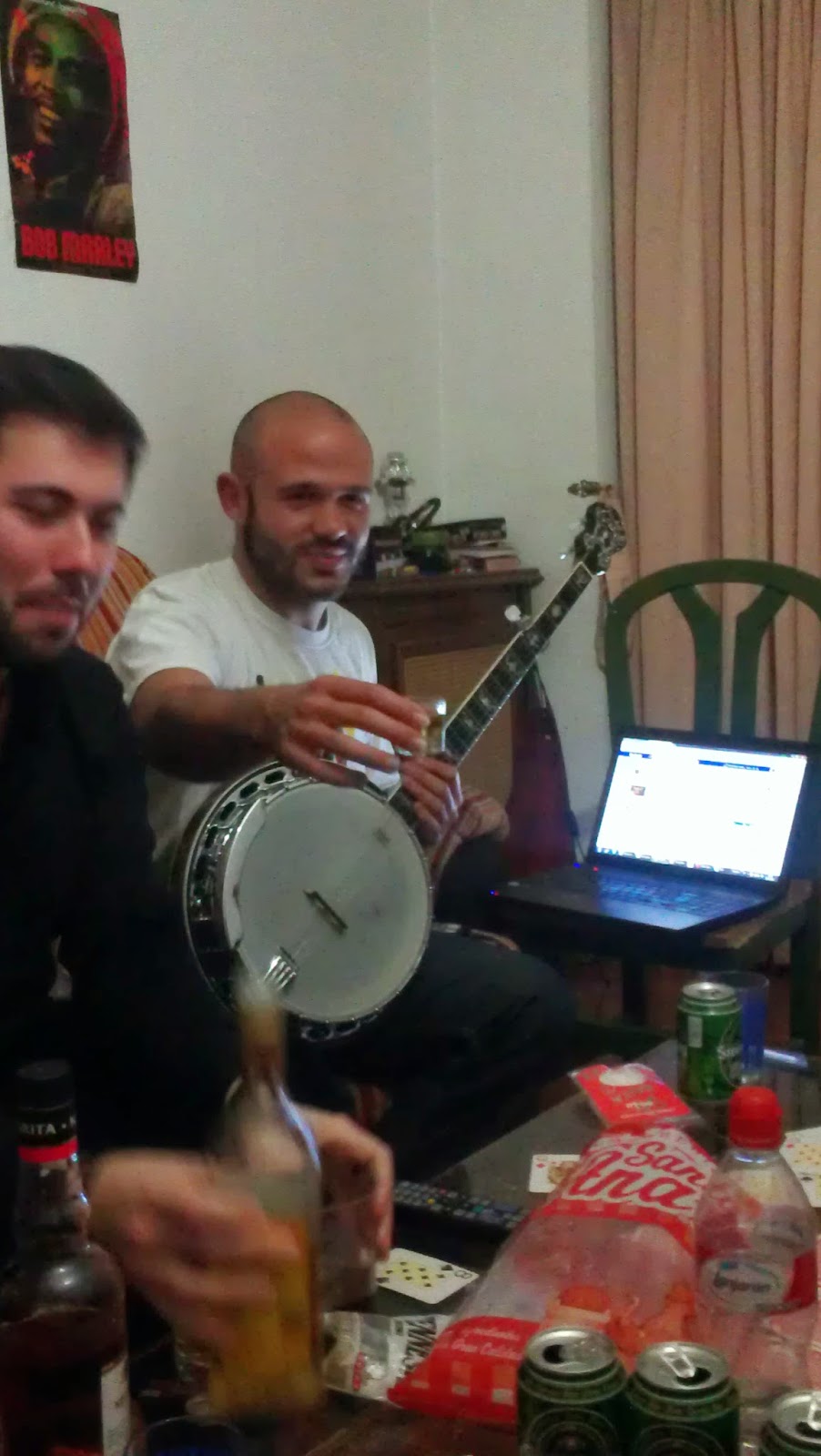.jpg) |
| Pre-gaming, botellon style. Try it at home! Banjo optional. |
My loose interpretation for botellon, is 'bring a bottle and some of those cups...'. Though they usually occur outside of the house in a plaza or park, I think it's far to call anything a botellon that involves more than 1 person bringing more than 1 bottle to share with the intent of drinking as much as possible before the night is over.
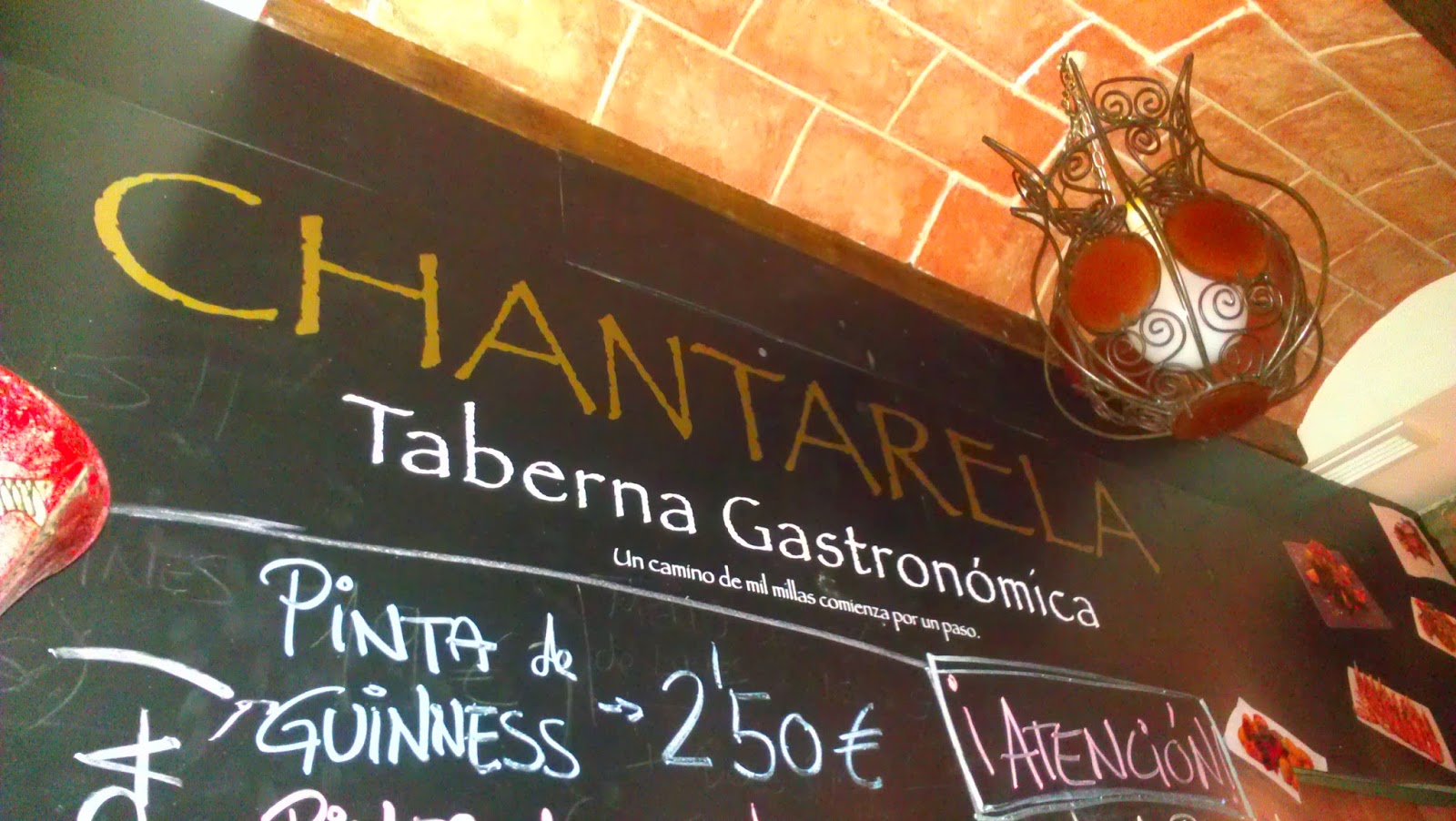.jpg) |
| First, to Chantarela for a few rounds of tapas and copas... what else? |
.jpg) |
| Our next stop was a crowded, energetic bar where this guy ogled me in the bathroom. I didn't mind. |
After a several hours of making the rounds, we night creatures all headed back to our coffins. By the time I made it back to my room and collapsed, it was a little after 4am.
La Morena Comes to Visit
"Oh crap, what time is it?" was my first thought upon waking the next morning. I was supposed to be meeting up with Dominique (aka, La Morena de Andalucia), who I had pestered until she agreed to come into Granada so we could hang out for the day. We strolled around Granada catching up on everything until it was time for me to head off to my appointment at the nearby hammam.
 |
|
|
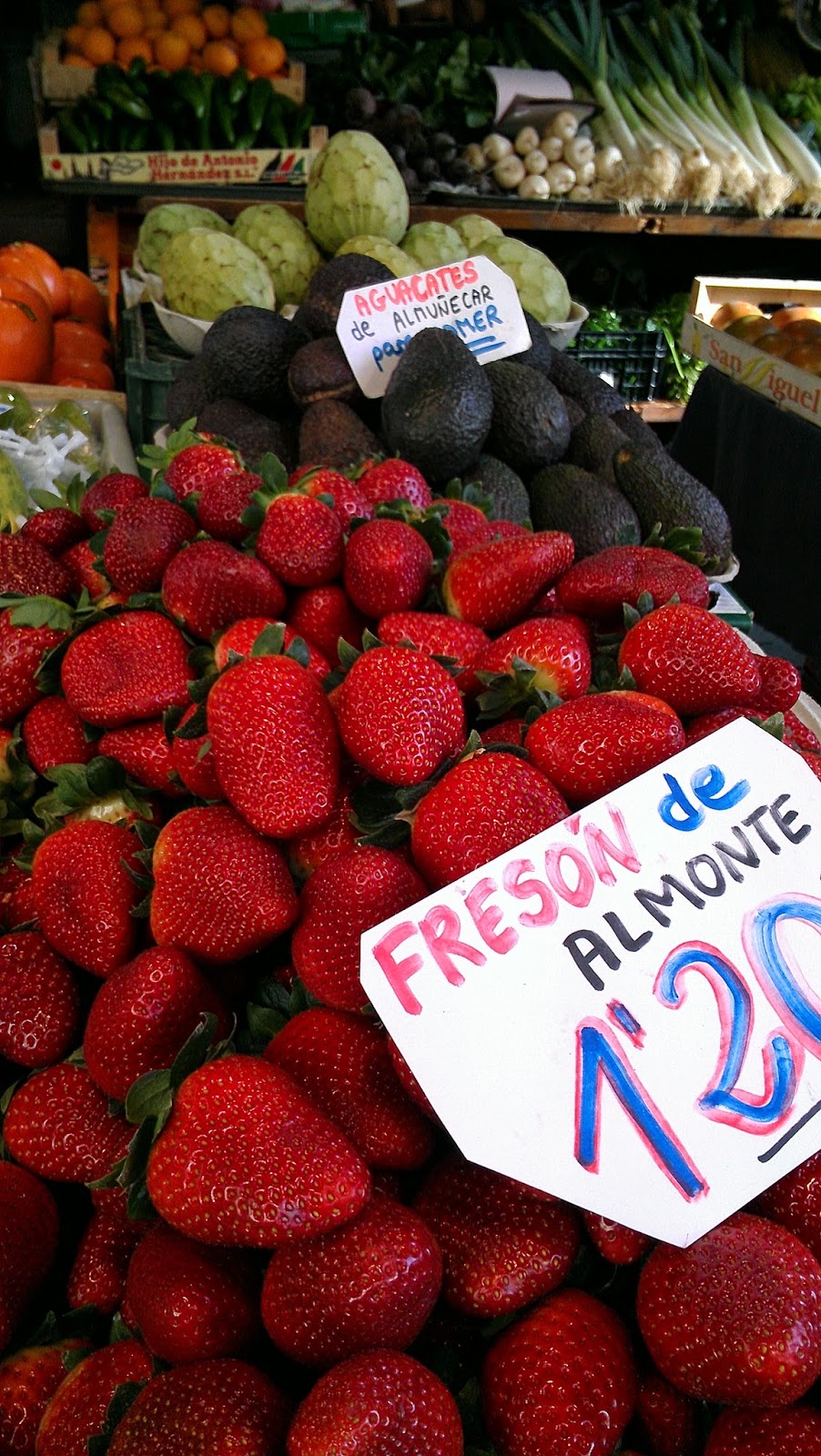.jpg) |
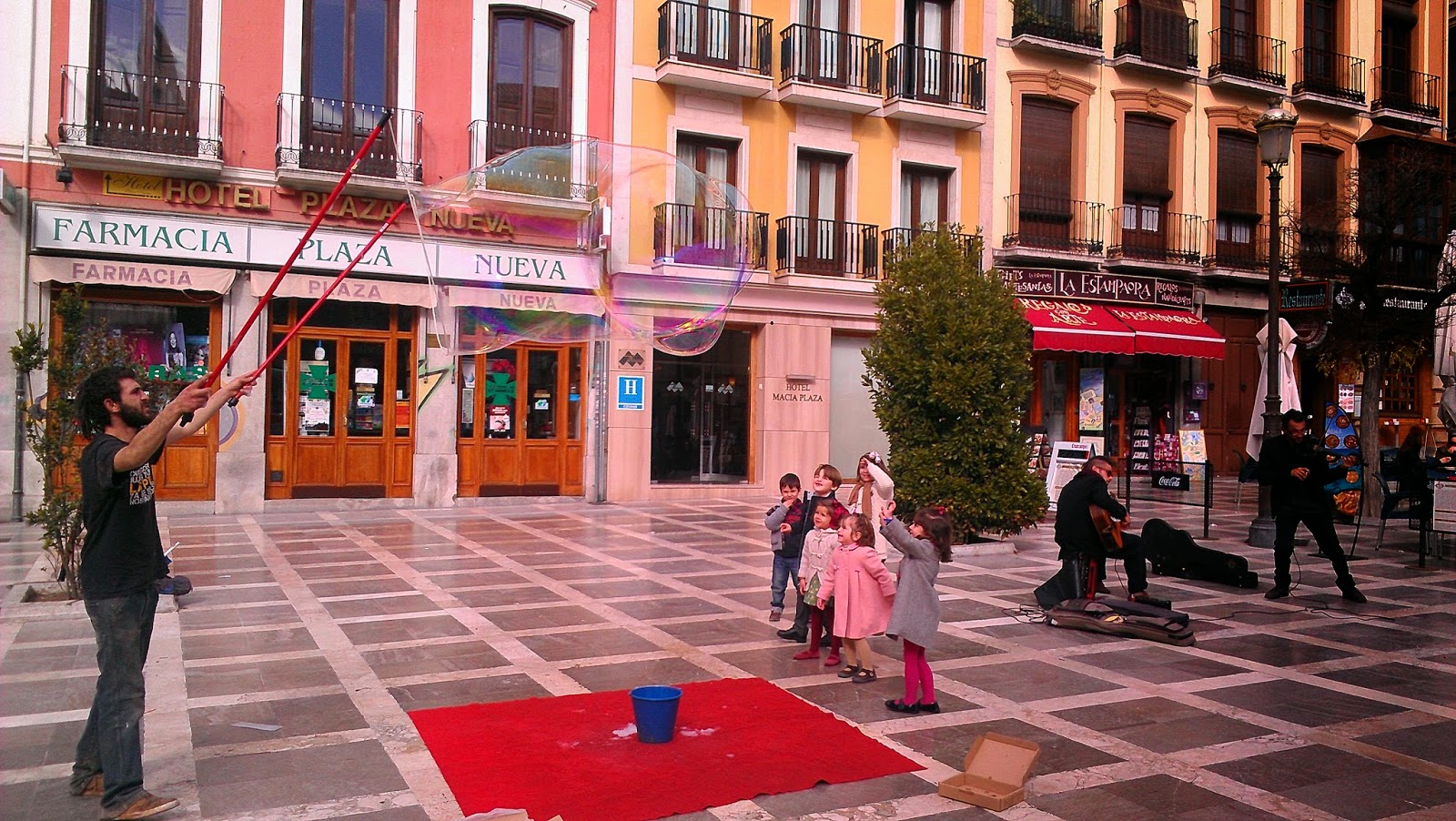.jpg) |
| kids playing at plaza nueva |
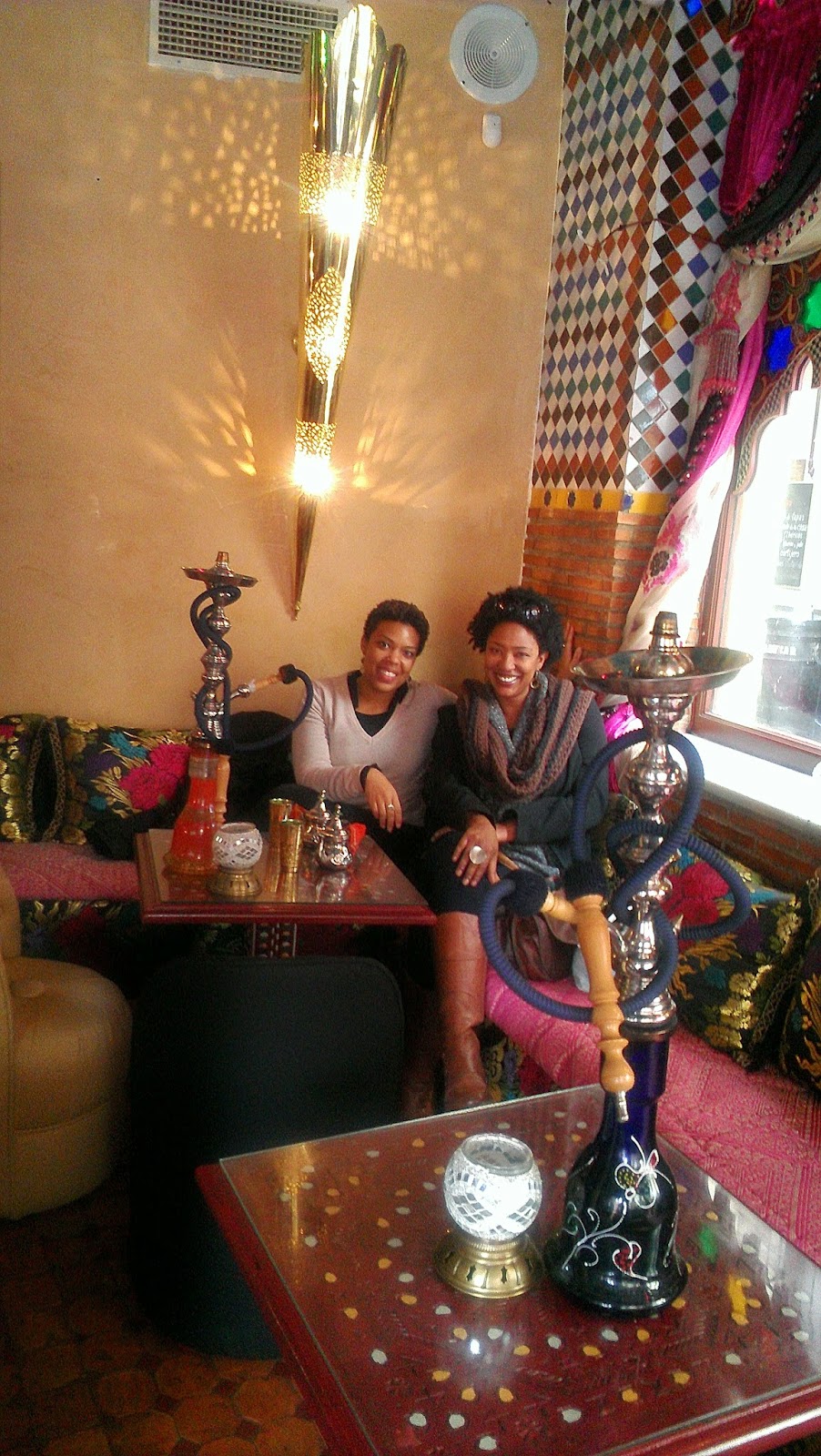.jpg) |
| 2 for tea - Dominque and me at a teteria on Elvira |
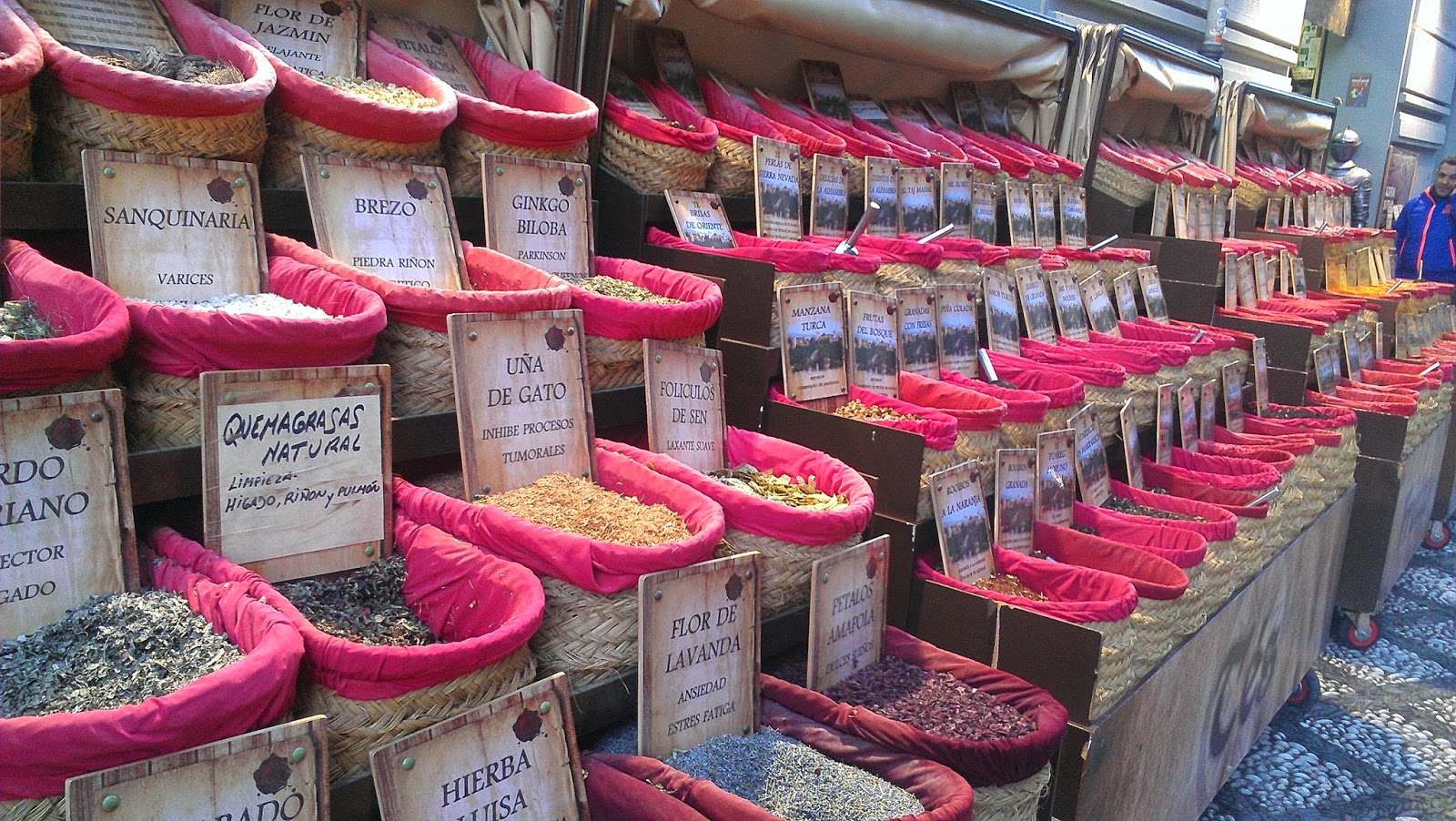.jpg) |
| spice vendor near granada cathedral |
Hammam Al Andalus
After all the walking at the Alhambra and the Albayzin the previous day, followed by a long night of 'botellon and bars', my poor body needed some rejuvenation. The Hamma al Andalus was right on time.
.jpg) |
| No pictures allowed inside. But I managed to sneak this one of me with my shoe shower caps. |
Inside the hammam are 3-4 'baths' or large soaking pools - each has a different temperature (from ice cold to warm-but-not-hot). There's also a steam room and a massage area. My entry fee of 25€ included admission to the baths for 2 hours and a 15-minute massage. The massage was pretty good, and I felt the price was fair, especially because I needed it so badly.
After the hammam, I met up with Dominique, Nicole, and Allison (aka, the out-of-towners) for tapas at Bella y la Bestia.
.jpg) |
| I'm giddy from an excess of carbs and a lack of sleep. |
Soon, it was time for Dominque to head back to Huelma. We hung out a bit more around Elvira, and then I saw her off to the bus station.
Shisha and Bars
Saturday night. Last night in Granada. So I start it off by meeting up with Brit for shisha and a nice cup of tea. We're both a little hungover from the night before, and before we leave the teteria, Brit throws in the towel and heads home for the night. Fare thee well o Hiawatha. Fare thee well, O mighty warrior.
I went on to meet up with the rest of the girls for a couple of bar stops:
First, at Chantarela (Yes, again. Cuz it was that good.)...
Then, at Poe, where Allison had her first taste of absinthe...
And finally, at one of these interesting Spanish drinking establishments I call 'shot houses' - a bar that's really popular because they serve a dizzying array of shots for about 1euro each.
All in all, it was a nice way to wrap up the weekend.
And it was a good thing I booked my return bus for the afternoon. I definitely needed to sleep in.
my culinary adventures in spain - eating out
As I mentioned in an earlier post, I've been surprisingly underwhelmed by the food here in Spain. Before coming here, I imagined that I'd be in absolute gastronmic glee over all of the delicious food available. Not exactly the case. But still, I've had some delicious and some very inspiring experiences with food that are definitely worth sharing.
EATING OUT
Tapas
The Spanish are best known for tapas. They invented the whole concept of small plates eaten / shared with friends over rounds of drinks. They've even made a verb to express the act of having tapas - tapear. Almost every Spanish restaurant offers a selection of tapas along with larger portions called raciones. However, there are two things that have left me feeling lackluster about the whole tapas experience: 1) every restaurant generally has the exact same selection of tapas (oh, look, they have croquetas!), and 2) none of them are prepared exceptionally well. They're not bad, mind you, but compared to my hyped-up expectations, they're not that great. Yet, thankfully, there have been exceptions:
In Sevilla, La Morena de Andalucia (aka, Dominique) showed me her favorite tapas restaurant, Duo. Located on the Alameda de Hercules, this little bar serves up some more creative twists on traditional Spanish tapas. The higher quality of the ingredients is noticeable as well. So far, this ranks as my #1 restaurant meal in Spain.
 |
| @ Duo Tapas in Sevilla. foreground: pulpo a la gallega; background: carillada |
In Cádiz, the tapas were tastier than the usual, and seemed even better because they were cheap and plentiful.
 |
| @ La Isleta Bar in Cádiz. left: carillada; right: pescado en salsa roma |
In Granada, the tradition of buy a drink, get a free tapa is alive and well. Unfortunately, the free tapas are mostly carb-heavy, not-that-great snacks. But Chantarela is a tapas bar that does justice to free tapas.
 |
| Standard free tapas in Granada. Carb-tastic! |
 |
| Free tapas at Chantarela in Granada. |
Beer
One of the very first things I learned when I arrived in Sevilla was how to order a caña. A caña is basically a half-pint of beer, and usually costs about 1€. It's common to have a caña before/with/after lunch, after work, or basically any time you need to take a quick break with a refreshing beverage. I've even started to use the caña as a standard for pricing other things. For example, "Wow. That bus ticket costs 2 cañas!" Spain has several local / regional beers that are only slightly better than Budweiser, Coors, or PBR. When you order a caña, you'll usually be served either Cruzcampo, Mahou, Alhambra, or San Miguel depending on what city you're in. All of them are your standard lager - refreshing, effervescent, uncomplicated and, honestly, quite perfect after a long day of walking around in the heat. But not too exciting in the way of flavor or body.
More recently, I've lucked up and found a few craft beer dispensaries. The phenomenon of craft and artisan beers is still fairly new here, so you often have to look a little harder to find a place with craft beers. Also, many of the shops or bars only have bottles, not taps. Still, there are some really good brews to be had, and the prices are on par with if not a little better than what you might find in the States. Right now, my favorite Spanish craft brewery is Naparbier - I've tried 2 of their Saisons and 2 IPAs, and loved them all. Plus, they have some really cool bottle art. One thing I've noticed in my tastings is that Spanish IPAs are not as over-the-top hoppy as others I've tried. They still have the prominent grassy or floral notes of an IPA but not the huge, hoppy 'bite' that I dislike about American IPAs.
 |
| Gulden Draak at La Tienda de Cervezas (The Beer Store) in Madrid. |
 |
| Just a sliver of the bottled selection at La Tienda de Cervezas, Madrid |
Freidurías
Ok. So there are these places here, right? They serve nothing but various fried things. It's like a Southerner's dream come true. Well, at least this Southerner's. You can find freidurias anywhere - in municipal markets, as standalone restaurants, or takeout-style counters. The menu selection in a freiduria consists of a variety of frituras, which I lovingly call, 'frieds'. You can choose from a selection of fish and seafood (anchovies, calamari, squid, etc.) or vegetables (eggplant, mushrooms, peppers, etc.). The best freidurias use a very light and crisp coating or batter for the fish, and I think most all of them use olive oil for frying. The result is a crispy, light-tasting exterior that doesn't mask the flavor or freshness of the fish. With a wedge of lemon to squeeze all over crispy, bite-sized pieces of fish hot out of the fryer, I am in heaven.
 |
| 'Frieds' at a stall in the municipal market in Algeciras |
 |
| Fritura from a take-away restaurant in Cádiz |
Chiringuitos
A chiringuito is a beachside shack or restaurant that specializes in whole fish cooked over an open flame. Talk about some serious food porn. My first chiringuito experience was at Malagueta, Malaga's most popular beach. After placing my order, I watched as an older gent delicately salted and skewered a whole fish, pitched it almost vertically next to a carefully tended wood flame, and lovingly basted it in olive oil until it was perfectly cooked and charred just-so on the outside. I have dreams about that day sometimes. Though a little pricey on my budget (at least here in Málaga), it's definitely worth the occasional splurge.
 |
| Yes - he is expertly cooking whole fish over a mound of burning wood piled into half of a boat. Yep. |
 |
| yep. |
Libations
My stateside mantra is, 'retail drinking is for suckas', and that hasn't changed much since moving to Spain. But when I do go for a cocktail at a bar, it's usually one of these:
Tinto de verano - A simpler alternative to sangria, tinto de verano is a blend of vino tinto (red wine) and a fizzy lemon drink found in Spain called casera. It's decent, but the casera sometimes has a strange aftertaste to me, so I plan to try making an at-home version with real lemons, sugar, and sparkling water or tonic.
Vermut - a fortified red wine that's sweet but strong and has lots of herbal undertones since it's usually infused with some botanicals. Served over ice with a slice of lemon or orange. I've only had it in Madrid and Cadiz, however.
 |
| Vermut and tostas in Madrid |
Chupito - The Spanish term for a shot.
Occasionally though, I head to Mañana, my favorite bar in Málaga. They make really good versions of classic cocktails like mojitos and manhattans, plus a few beer cocktails like the James Brown.
 |
| Tomax preps for a 'make-do mojito' (they were out of limes) |
 |
| Xamot carefully crafts the James Brown - a beer cocktail |
Fast Food
The most commonly sighted fast food restaurants here are McDonald's and Burger King. Many of the menu items are the same as in the States, with some differences to suit local tastes. For instance, McDonald's serves gazpacho in the summer. They also serve a habit-forming alternative to the already addicting McDonald's fries, called 'patatas deluxe'. They're little seasoned potato wedges that pair perfectly with a McBeer.
 |
| My favorite after-school snack: patatas deluxe and a beer |
One other notable difference is the prices at fast food chains (at least the 2 burger chains). If memory serves, they are more expensive than at home. A regular-priced combo meal at McDonalds can cost 7€ or a little more; and the 'daily special' is still pretty expensive at 5.50€.
It's the little differences.
a week in the life of an english language auxiliar in spain
Monday
7:45am - Head out the door and down the hill to meet my ride at 7:50. On Monday mornings, I ride to school with Pepe, a biology teacher at IES Vega de Mar in San Pedro de Alcantara. On the 10-minute drive from Marbella, we talk about our weekends and other pleasantries. It's good practice for both of us. Pepe tries to speak in English, I try to speak in Spanish. Hilarity often ensues.
8:00am - We arrive at school and enter the Sala de Profes (aka, the teacher's lounge, aka 'club profe'). After a round of 'holas' and 'buenos', Pepe and I head straight for our mugs to prep our morning coffee. We take turns treating each other. (Coffee isn't free for profes. It costs .50€). I sit enjoying my coffee (and if lucky, my take-along breakfast) and listening to the rapid-fire convos between the other profes.
 |
| arriving at school |
8:15am - The bell rings for first period. By now, I am used to the sound of it. Though when I first arrived, I almost had multiple heart attacks, since the bell sounds something like a cross between a fire alarm and an air raid siren. Everyone heads off to their classes. Since I don't have class this hour, I sit in the lounge and prepare for the day ahead.
9:15am - Time for my first class. History and geography with the 2nd level bilingual students. When I walk into class, several students greet me with a very rehearsed, 'Hello, Kisha. How are you?" The rest of them are chatting loudly, running around the classroom, or horseplaying with their friends. I have to shout 'Ready?' at least 2 or 3 times to get them to settle down. Before getting into today's lesson, I start off by asking if anybody did anything fun or interesting over the weekend. Many of the students are as eager to share as I am to listen, plus it gives them a chance to practice speaking English in an unstructured way. After everyone has shared, we move on to the lesson. Today, we are reading about daily life in the Middle Ages. I ask for volunteers to read the English handout the profe has selected. Each volunteer first reads a few sentences from the lesson in English, then translates the same into Spanish. We go over unfamiliar vocabulary words as a group, and I answer any questions they may have. The profe, Enrique (aka, Quique), helps out with any Spanish-English translations that I don't know. Throughout the lesson, I have to stop several times to quiet the class back down or call out a student who is obviously not paying attention.By the end of class, Quique has worked up a sweat and the kids have worked my nerves.
 |
| such adorable little scamps. |
10:15 - First class is over. I head back to the lounge to hang and prep for my next class, which isn't until 11:35.
11:35 - My second history class. This time with the first-year students. They are quickly becoming my favorite group of the 3 that I work with. They aren't as boisterous as the 2nd years, but they have way more energy and interest in learning than the 3rd years. However, their level of English is much lower, so it can be a challenge communicating or coming up with in-class activities that they will easily grasp. After the 'how was your weekend' chat, we delve into today's lesson: the government of ancient Rome. Usually we read and translate, but today, I divide the class into several groups. Each must come up with a solution to a problem that the Roman citizenry is facing. They must decide which members of the government they need to work with, and propose their own solution to solve the problem. Not surprisingly, one student asks if they have to give their explanation in Spanish or English. I shake my head, smile, and say, "When I'm here. It's always English. Vale?" Surprisingly, the students really take to the assignment and they come up with some creative, if not entirely practical solutions.It´s a rare moment of success. I relish in my unquestionable auxiliar awesomeness.
12:35pm - Technically, I'm done for the day. But I have an hour of 'coordination', which any of the teachers can use to chat with me about lessons for the coming week or any special projects or activities they want me to prepare for the class. It's rare that anyone does, but I stick around anyway, just in case.
1:45 - 4:00pm - Workday is officially over! Since it's Monday, I'm headed to do some grocery shopping. I catch the #4 urbano (aka, local / intracity bus) which stops right outside of the school, to Puerto Banus. From there, I catch the #1 urbano to La Cañada, Marbella's huge shopping mall. By now, I'm starving, so I stop at McDonald's in the mall for an after-school snack of patatas deluxe and a beer. Total cost: 2.35€. Inside the mall there is also Alcampo, where I prefer to do my shopping. It's equivalent to a Super Wal-Mart, so I can get groceries and personal / household items all in one stop. I've finally gotten into the habit of bringing along my backpack and a large, reusable shopping tote. Plastic shopping bags are usually not free in any store in Spain - checkout clerks almost always ask: "Bolsa quiere?" ("Want a bag?") instead of just giving you one - so it literally pays to have your own. Also, the backpack helps me transport heavier items on the bus ride and walk home. I try to stick to my 20-25€ weekly grocery budget, but sometimes I go a bit over if I have to buy things like deodorant or lotion.
 |
| la canada - where i do most of my grocery shopping |
4:00pm - I catch the bus from La Canada back to the main bus station in Marbella, a 7-10 minute walk from my house.
4:30 - Home! Time to put up the groceries and rest a bit before making dinner.
7:30 - Time to unwind for the evening. Maybe I'll stream a movie online, straighten up my room a bit, hang out in front of the TV with my roommates, or just surf the Internet for a few hours before going to bed. Most likely, I'm still recovering from a long, eventful weekend and I could use the rest.
 |
| relaxing after school with purp, the house kitty. |
Tuesday
8:00am - The sunlight streaming in my window wakes me up. It's my late day, and I don't have class until 12:45. I pull the covers over my head and half-sleep for an hour or so more.
10:00 - 11:30am - Even though I tell myself I'm going to accomplish a ton of stuff before heading to school, I manage to fritter away time until it's almost time to catch the noon bus that will just barely get me to school in time for my 12:45 class.
11:45am - 12:45pm - I make the 7-10 minute walk from my house to the main bus station. I catch the noon bus from Marbella to San Pedro. The bus ride takes about 40 minutes and costs 1.23€.
12:45 - 2:45pm - I have PE class with the 2nd year students. I spend the first half of class explaining 2 different playground games that are commonly played in the US. The students take notes and ask questions before trying the games for themselves. The second half of class I spend in the teacher's lounge correcting an English presentation about basketball that the teacher has prepared for a different class. Next, it's off to music class with the first year students. I often get the feeling that the music profe doesn't exactly know what to do with me in class. Today, is no exception. The students take turns reading from the English textbook (today, it's about the Baroque period), and I ask them questions about what they just read.
 |
| preparing to teach the kids about four square (the analog one) |
 |
| in music class |
 |
| after-school commute / carpool from san pedro to marbella |
Wednesday
7:45am - Off to meet Pepe!
8:15am - 9:15am - On Wednesdays, I alternate between music and PE classes. Today, it's PE class with the 3rd year students. I read the presentation on basketball in English, and the profe translates as needed into Spanish. The students make notes about the rules, players, and key vocabulary related to the sport. Apparently they will be tested on this later.
9:15am - 10:15am - English class with my favorite teacher in the school - Mila, the bilingual coordinator. The students' behavior is markedly different in her class. They are quiet, respectful, and attentive, even though I have to work a little to get their energy level up. Today, we discuss adjectives. I write various adjectives on the board and call on students to guess what they mean. Afterwards, I ask the students to write down 3 adjectives that describe themselves, and we go around sharing all the answers. There are some creative and some downright hilarious responses. This is one of the few classes where I truly get to engage with the students, and I think they enjoy the interaction as much as I do.
10:15 - 11:35am - No class until later, so I lounge in the sala de profes, chatting with some of the teachers, or prepping for tomorrow's classes.
 |
| The bilingual teachers have a meeting in club Profe. From L to R: Enrique (Quique), Luis, Paco Serrano, Meritxell, Mila. |
11:35am - 12:35pm - PE with the first years. A listening exercise for today. I read a text about juggling, which explains the history of the sport and some different methods, using simple English terms. After I finish the reading I ask the students prepared questions based on the text to assess their level of listening comprehension.
12:35 - 1:35pm - Done for the day! I make the 15-20 minute walk down the street, across a ravine, up a hill, across an overpass, and along the side of the highway to catch my bus. On the ride home, I study my Spanish dictionary, read, or make notes about today's class.
 |
| after-school commute - crossing the ravine |
 |
| after-school commute - on the overpass |
Thursday
11:30am - It's Friday! Well, at least for me. It's my last day of classes for the week. I arrive at the school just in time for my first of 2 math classes.
11:35am - 1:45pm - Back-to-back math classes with the 1st and 2nd year students. I already hate math. So having to 'teach' it in English to non-English speakers is not exactly my favorite activity. The profe usually has me work with the students using a prepared handout of exercises. I explain the instructions in English and help the students use English to read the equations and explain their solutions. Most of the time, it goes well, but there are some differences in the way math is done/taught in Spain (commas instead of decimals, methods for division, etc.) that leave me scratching my head. The math profe usually reverts to speaking completely in Spanish (an absolute no-no in my other classes) before the end of the class, so am I often left smiling and pointing like a mute game show host while secretly counting the seconds until class is over. Did I mention that I hate math?
 |
| but when it's one of the students' birthday, they do this - which makes math less awful. |
1:45 - 2:45pm - History and geography with the 3rd year students. A cool class since the students are older, and we often get into some pretty deep conversations. Today's topic: globalization. I lead the students in a brief discussion on how we have all been impacted by globalization. I ask them for examples of music, food, clothing, and TV programs that they like but are not from Spain. Then we do some reading and translation, and finally finish with a video that I found on the topic. The students give a huge round of applause after the video, and I spend the last few minutes of class having them share their opinions on why they think globalization is good or bad. When the bell rings, I get the feeling that all of us are sad that class is over.
Well, maybe not too sad.
surprising / annoying / amazing things about spain
surprising things about spain
how NOT amazing the food is.
The food in Spain is definitely not bad. But it isn't nearly as amazing as I'd expected it to be. Part of that could be because I live in Marbella, which isn't exactly hailed for its cusine. The other part could be that, given my teaching assistant's salary, I try not to eat out too much. When I do eat out, I go for the best value. Maybe if I could afford to splurge on some higher-end places, I'd have a different experience. But for now, I remain surprisingly underwhelmed.
 |
| pan con aceite y tomate. a typical spanish breakfast. when it's good, it's good. but usually it's just soggy bread. |
it's kind of country.
I live in Andalusia - the south of Spain. Among Spaniards, it has a pretty similar reputation to the South in the United States. Spanish people who live elsewhere seem to think Andalusians are 'slower' and have a funny-sounding accent. Even though I live in a fairly large city, it's quite common to see touches of rural life on a daily basis - like the horse-riding vaquero that grazes sheep, cows, and steers in a big field near my school. Also, I was surprised that much of Spain seems to be uninhabited. When I've flown or taken a long-distance train, I've seen large expanses of land that have no cities or towns to speak of - only the occasional pueblo / village or often just a small house or farm in the middle of nowhere.
 |
| cattle grazing near my school (and adjacent to a major highway) |
how cold the houses are in winter.
Before coming here, I knew that many Spanish houses lacked central heating, since most are built to be naturally cool during the sweltering summer months. But nothing could have prepared me for how cold it would be inside the average Spanish home from January to early March. Even when the temperature outside was Fall-like, the temperature inside was much chillier. With electricity being very expensive, space heaters are generally out of the question. And even if they weren't financially impractical, the lack of insulation, and the heavy use of marble, tile, and stucco for interiors would render them almost useless anyway. My #1 saving grace was a hot water bottle that my roommate wisely suggested I purchase, and was my nightly companion for my first two months here. There were many nights that I went to sleep muttering profanities under my breath about the cold, and many mornings where I could see my breath in front of me while getting ready for school. Thankfully, all that seems like a dim memory now that Spring is here.
 |
| i actually bought a space heater, but it ended up collecting dust once i found out how expensive and ineffective it was. |
 |
| my 'hot water bottle boo' in granada |
annoying things about spain
dog poo. everywhere.
Spanish people love their dogs. It seems like almost every family here has at least one. And every one of them is cuter than the last. Yet I have no idea why these people feel it's ok to let their cute little dogs leave unsightly poo all over public areas. If you're walking down the sidewalk, there's no such thing as absentmindedly taking in the sights around you. You'd better keep your eyes focused on the sidewalk or else you will definitely end up stepping in one of the many mini monuments of poo peppered all along your path.
 |
| poo |
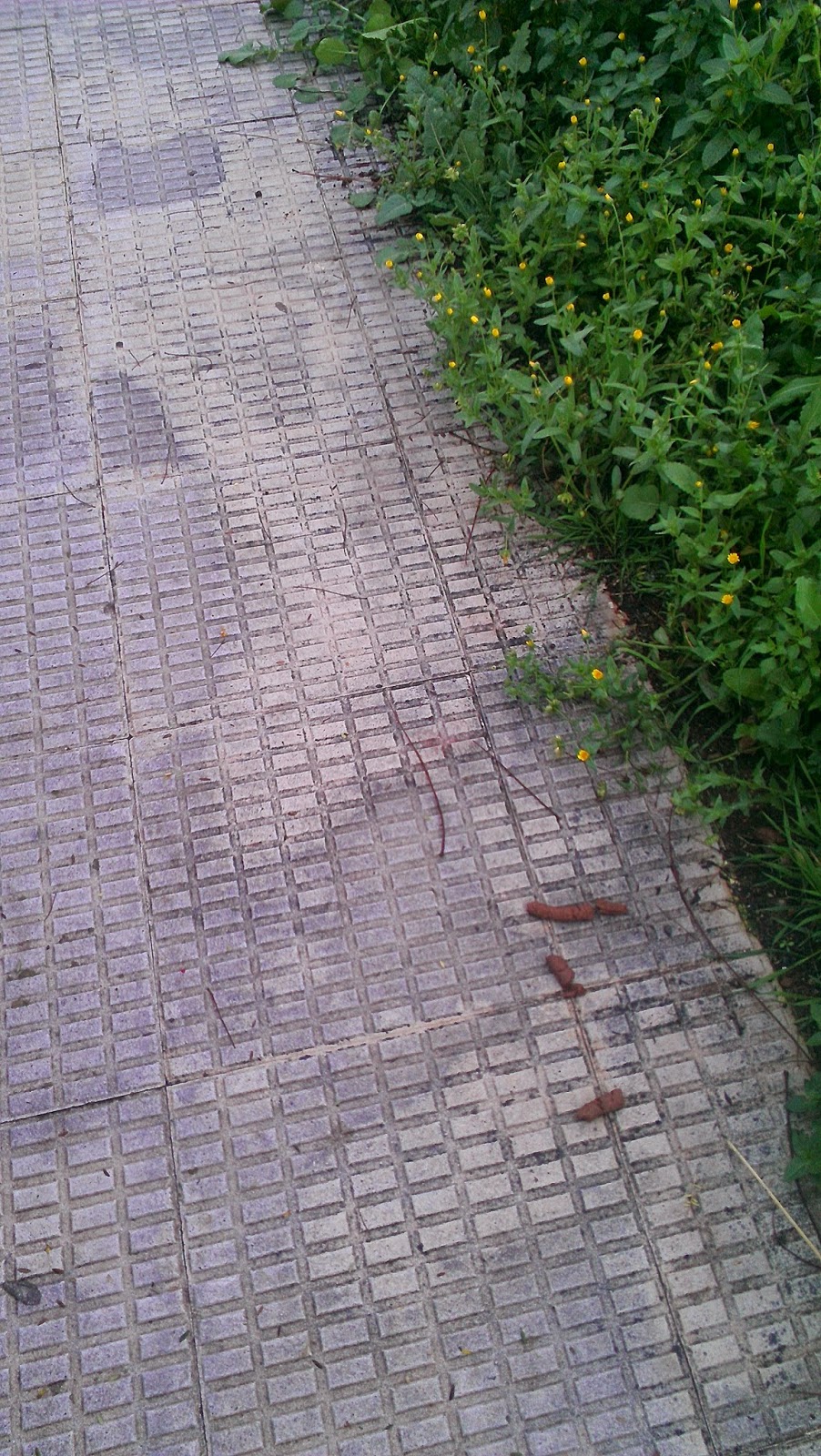 |
| poo |
 |
| and more poo |
spanish people can't walk. or stand. or generally congregate in large groups.
There are some cities where it's almost a pleasure to walk in. In crowded, pedestrian-heavy cities like New York, London, or even Amsterdam, most people have figured out how to navigate the streets on foot so well, that you can tell a tourist from a local by the way they walk. The folks in Spain have acquired no such talent. Spaniards don't walk so much as they meander. On a given day, while walking the streets of almost any city in Spain, at least one of the following pedestrian 'violations' are bound to occur:
- Stopping short for no apparent reason.
- Walking 3 or 4 abreast on a narrow sidewalk at a snail's pace.
- Darting out of a doorway into oncoming foot traffic.
- Tripping or hip-checking another pedestrian with a stroller or rolling bag.
- Having an involved conversation while blocking an entrance/exit.
- Doing 1 or more of the above without awareness or apology.
shhh... it's a secret.
There's a certain clandestine nature about vital information in Spain. Info that you would assume should be readily available or clearly communicated, often isn't, and if you don't ask specifically, you might only get a piece of the full picture. This secret but valuable info could be anything from a bus schedule or ticket price, to exact directions to a location you're looking for, or even what day you will get paid on.
amazing things about spain
there is no famine of beauty.
Geographically speaking, Spain pretty much has it all. Glittering beaches, impressive mountains, rolling countryside. And since there are those large expanses of unpopulated space, it makes for some really lovely, truly breathtaking vistas. I can't count how many times I've involuntarily whispered to myself, 'That's beautiful!' There are so many lovely natural and architectural sights in this country that sometimes I think to myself, 'Ok, Spain. Enough already! I get it. You're beautiful'.
the lifestyle.
In general, Spanish people are more relaxed than Americans about... everything. Sometimes, this can be irritating (as is the case with customer service), but for the most part, it's a huge plus. If there's one thing the Spanish are good at, it's enjoying life at their own pace. This is not to imply that the Spanish don't have worries or issues that they struggle with on a daily basis, but rather to highlight that there's not also a constant undercurrent of external stress from hectic schedules, long work hours, few vacations, and infrequent naps that they have to contend with. Besides that, most Spaniards seem to make the most of what they have, even if they only have a little. The often used Spanish phrase, 'no pasa nada', is the Iberian equivalent of 'no problem, mon' or 'no worries, mate', and it adequately sums up how many people here approach life.
the transportation.
Even without a car, it's incredibly easy to get around within a particular city, and especially between cities. The buses and trains within Spain are extremely reliable and comfortable. Way better than Amtrak and Greyhound in the States. High-speed trains can be a bit pricey if you're on a tight budget, but offer huge time savings. Buses are usually very affordable when travelling between cities, although they may not be the most convenient where timing is concerned. Yet both are clean, comfortable, and well-serviced. It sets the perfect stage for easy, affordable weekend excursions.
how amazing the food is.
While restaurant food underwhelms me, the quality and price of grocery store goods makes me very happy indeed. Mind you, I can't find everything that I'd normally cook with at home, but the produce and meat available here is of much better quality than in the US. And the prices for most non-packaged goods are comparable, if not much better. Especially the fish and seafood. Seriously, there are days when I just go to the seafood counter at the local grocery store and just drool. There's stuff there that I have absolutely NO idea how to cook, but I geek out just looking at it.
class is in session
My first day of class was Monday, January 13. I awoke as excited as I used to be on the first day of school when I was a kid. I had even laid out my clothes the night before, choosing just the right combination of items that I hoped conveyed the message, 'I'm cool, but I'm here to work, too'.
Like most first days, it was a bit of a blur. I arrived and met the school's bilingual coordinator, Mila, who, for all intents and purposes is in charge of me. She was extremely excited to see me and I could tell that she was more than a little bit relieved that I was older than the previous two auxiliaries that had been at the school before. The one from the previous year, she told me, was a guy named Curtis from New Orleans. Apparently he was nice enough, but according to Mila, he was more interested in vacationing than actually teaching or putting in work in class. Plus, many of the students and teachers found his English very difficult to understand. I assured Mila that even many Americans found New Orleanian English difficult to understand. The most recent auxiliar, whom I was replacing, had returned to America after only 2 days in town. She had written Mila an email after only 1 day in class explaining that she was very depressed and needed to return to New York immediately to see her therapist. Because of this, the school had been without an English assistant for pretty much the whole school year. It was clear that the bar for performance had been set pretty low, so I figured I wouldn't have to try too hard to make a good impression here.
One curious note was that apparently, some of the teachers had been expecting a male to show up. They thought the name Kisha sounded like a guy's name. No idea why.
Some other observations after my first few days on the job:
- The school bell sounds like a cross between a fire alarm and an air raid siren. Near 'bout had a heart attack the first time I heard it! Grabbed my stuff and everything. Then saw everyone else just carrying on like business as usual, so I figured it must be normal.
- A few of the male teachers were kinda lecherous in their introductions. After Mila escorted me into the teacher's lounge, they were falling over themselves to say hi or try out their English. One even asked me (half-jokingly) which of them I thought was most handsome. Lawd. They're totally harmless, though. Pretty typical behavior for Spanish men, from what I hear.
 |
| hangin' in the teacher's lounge, aka 'club profe' |
- Everyone at school has been extremely eager to help out with whatever I ask for. I mentioned to one of the Spanish teachers that I could use some help with my Spanish, and the next day, she presented me with a stack of workbooks for me to take home for as long as I want. After hearing me lament about my long bus ride from my place to school, Mila went around asking everyone if they could let me carpool with them, I've already got two folks that I now ride either to or fro with multiple days a week!
 |
| my spanish workbooks |
- The kids here are very boisterous. Not bad, but extremely talkative and undisciplined. I am already trying to set expecations for how I want them to behave, but I can tell it's going to be an uphill battle.




















































































.jpg)
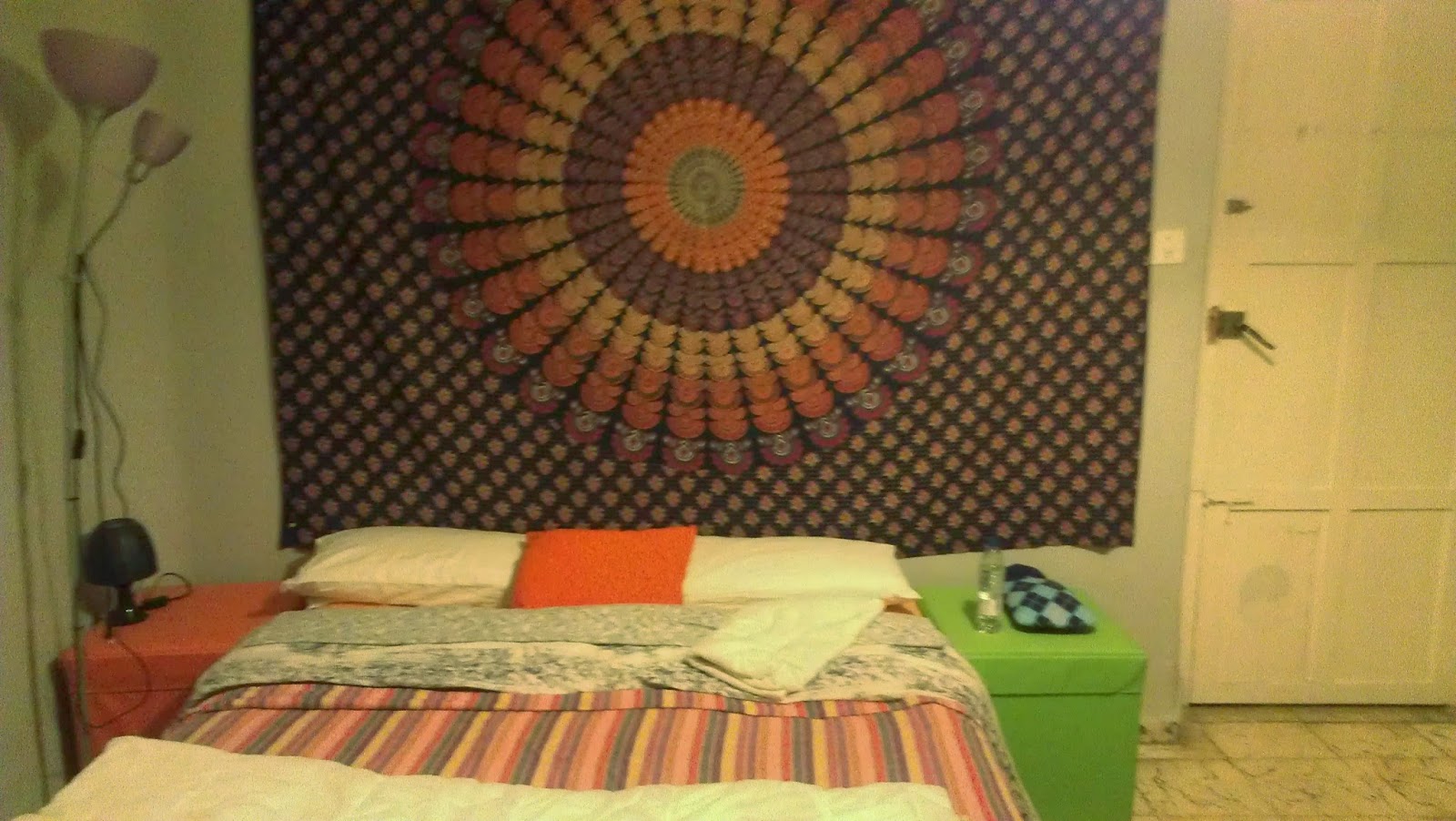.jpg)
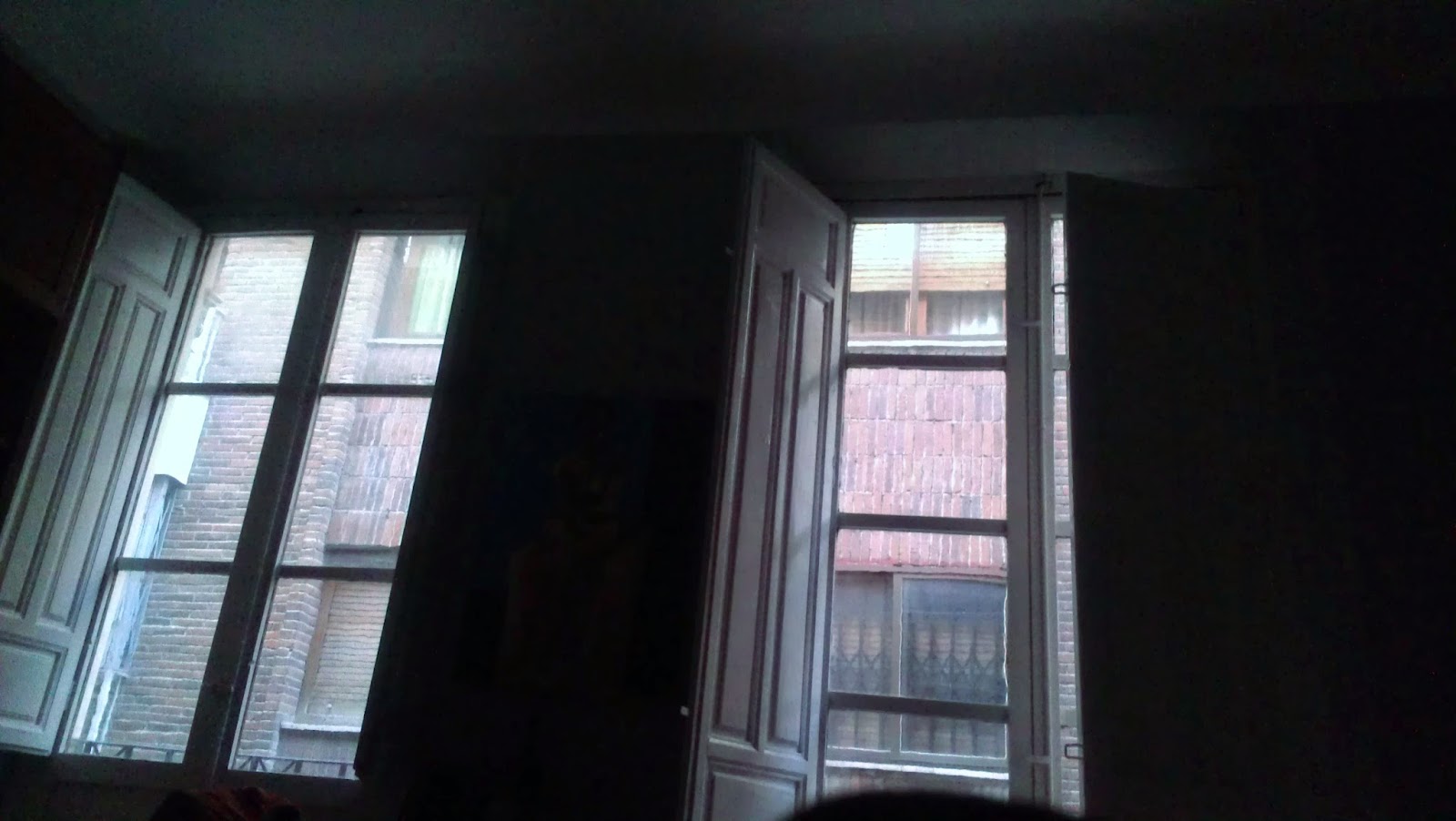.jpg)
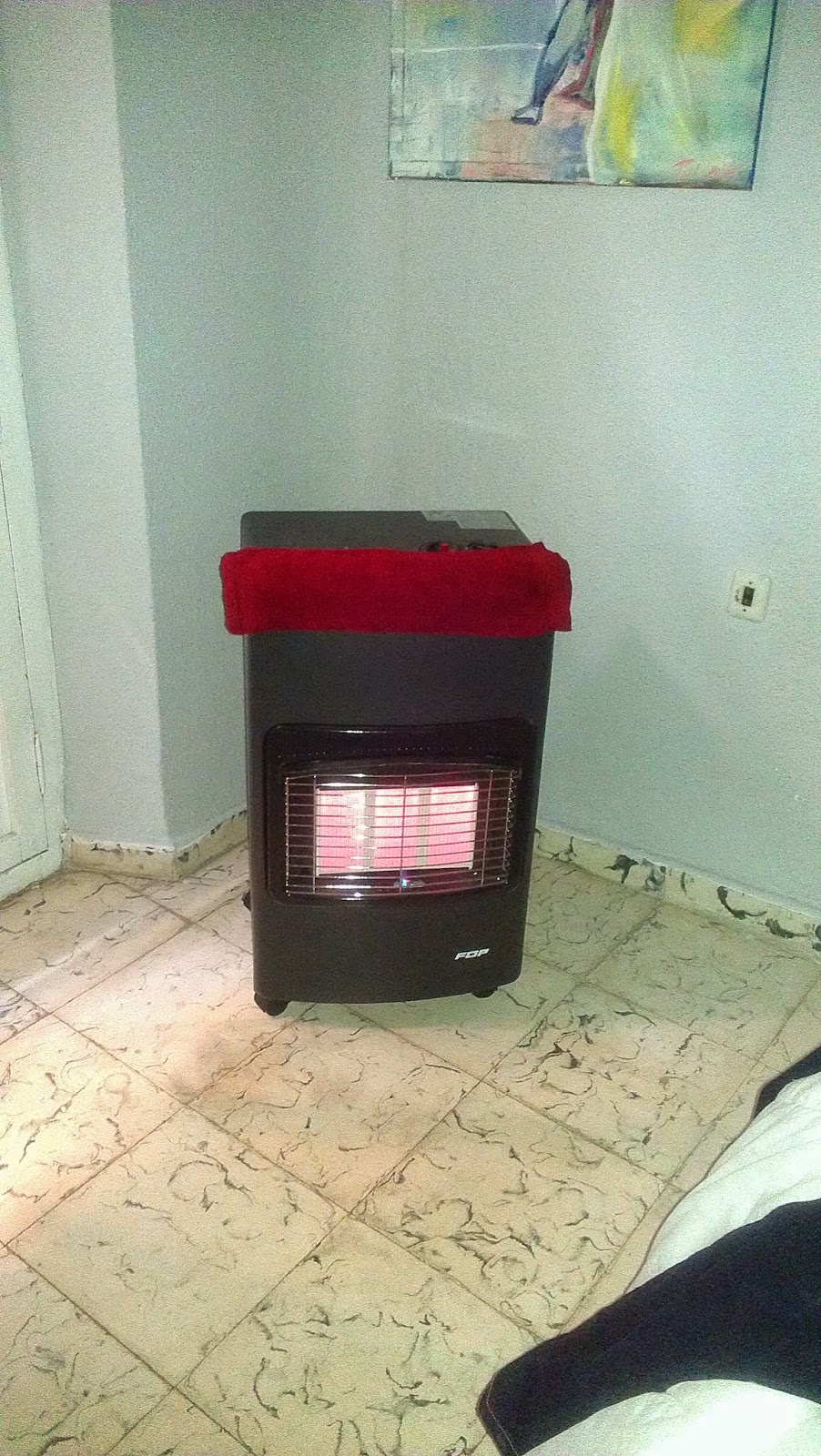.jpg)













































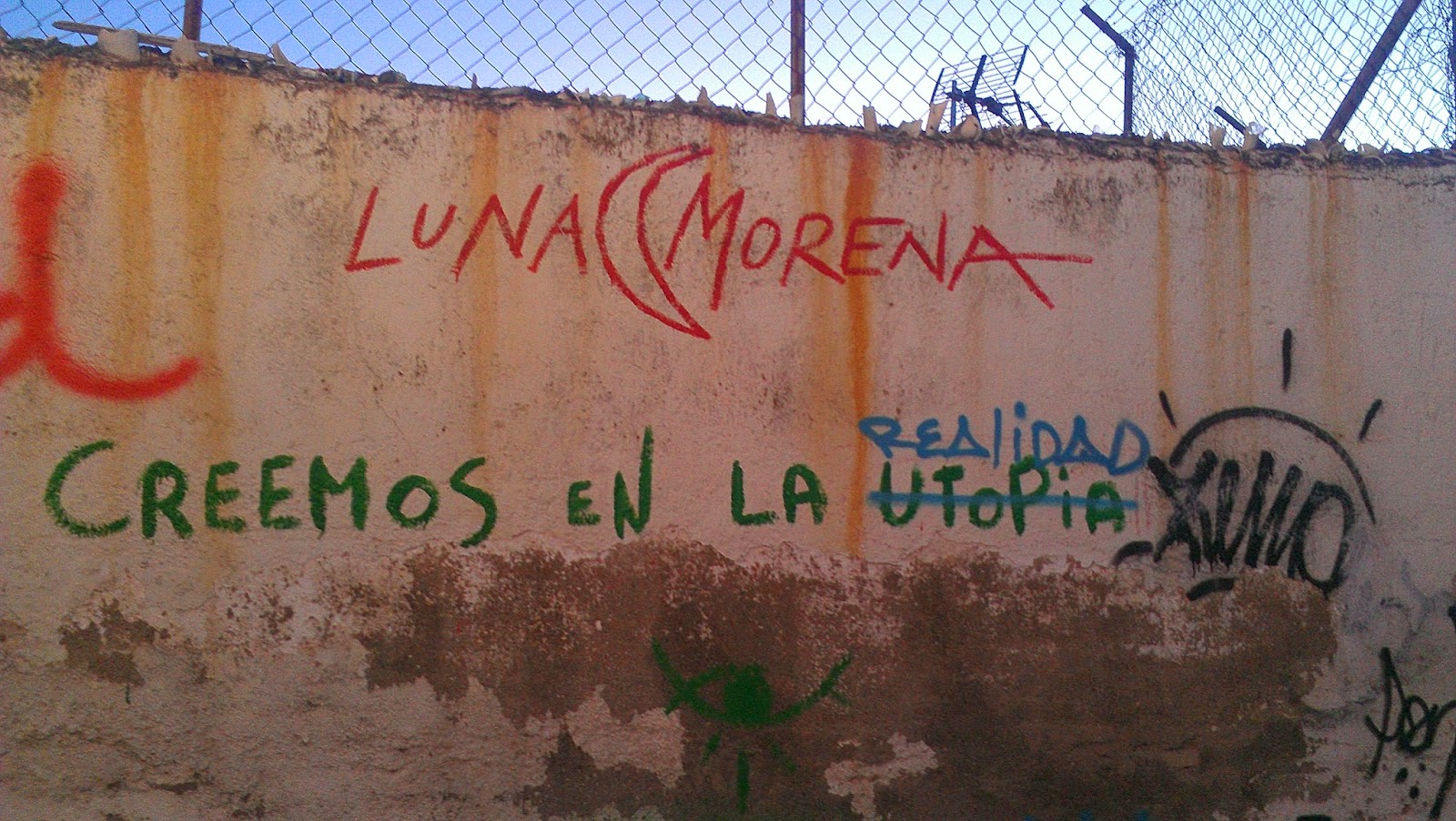


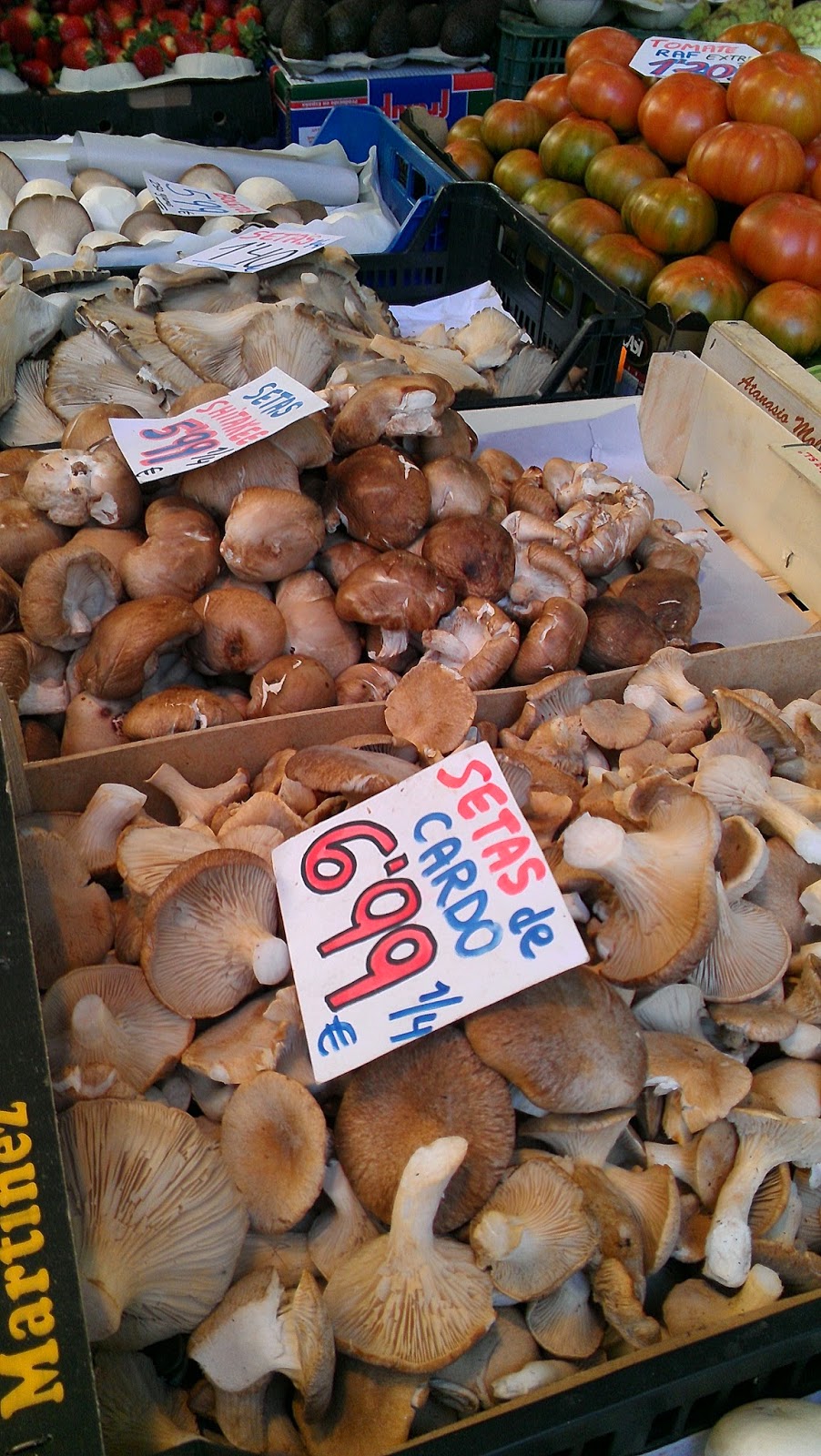.jpg)

.jpg)

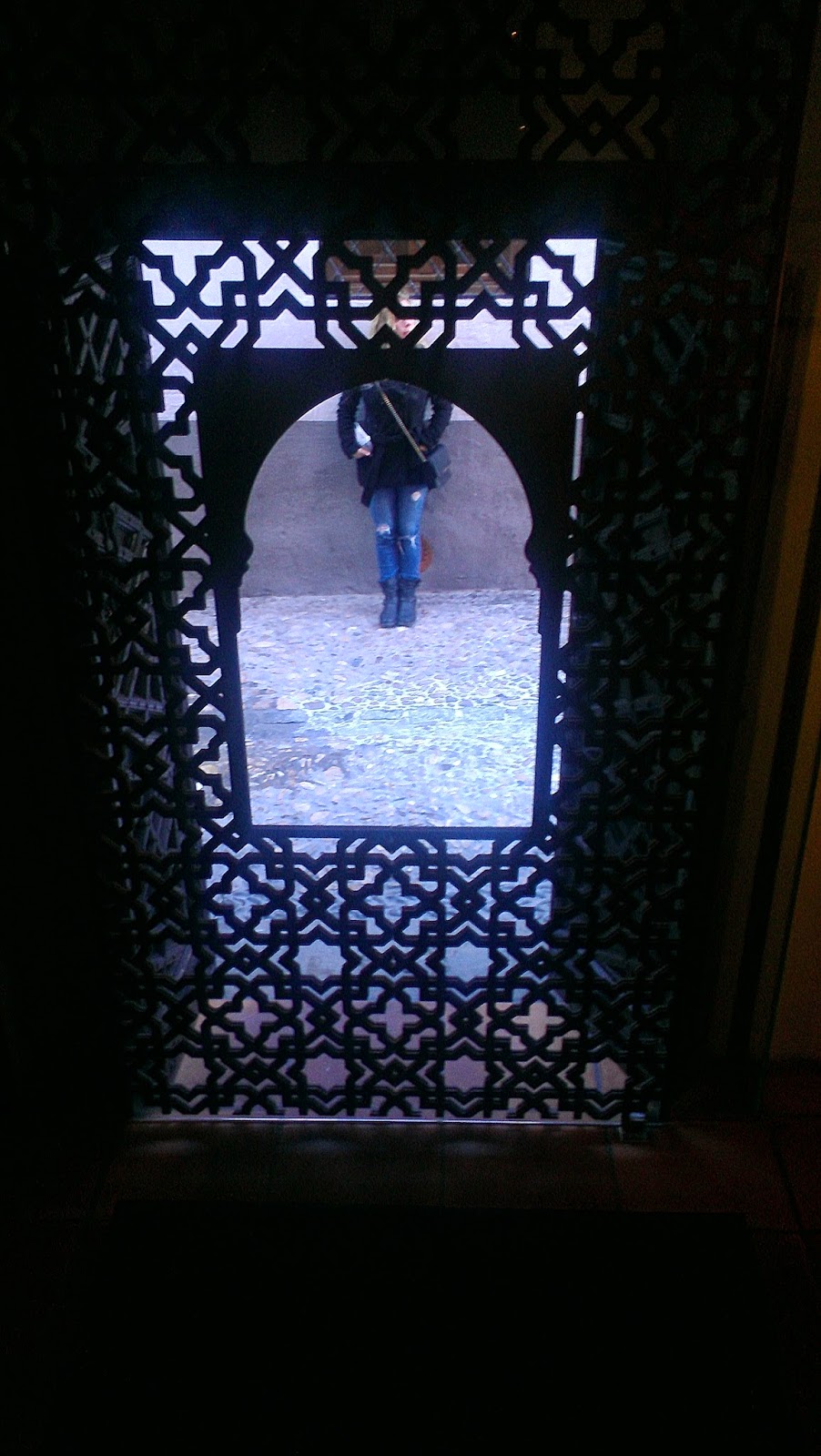.jpg)
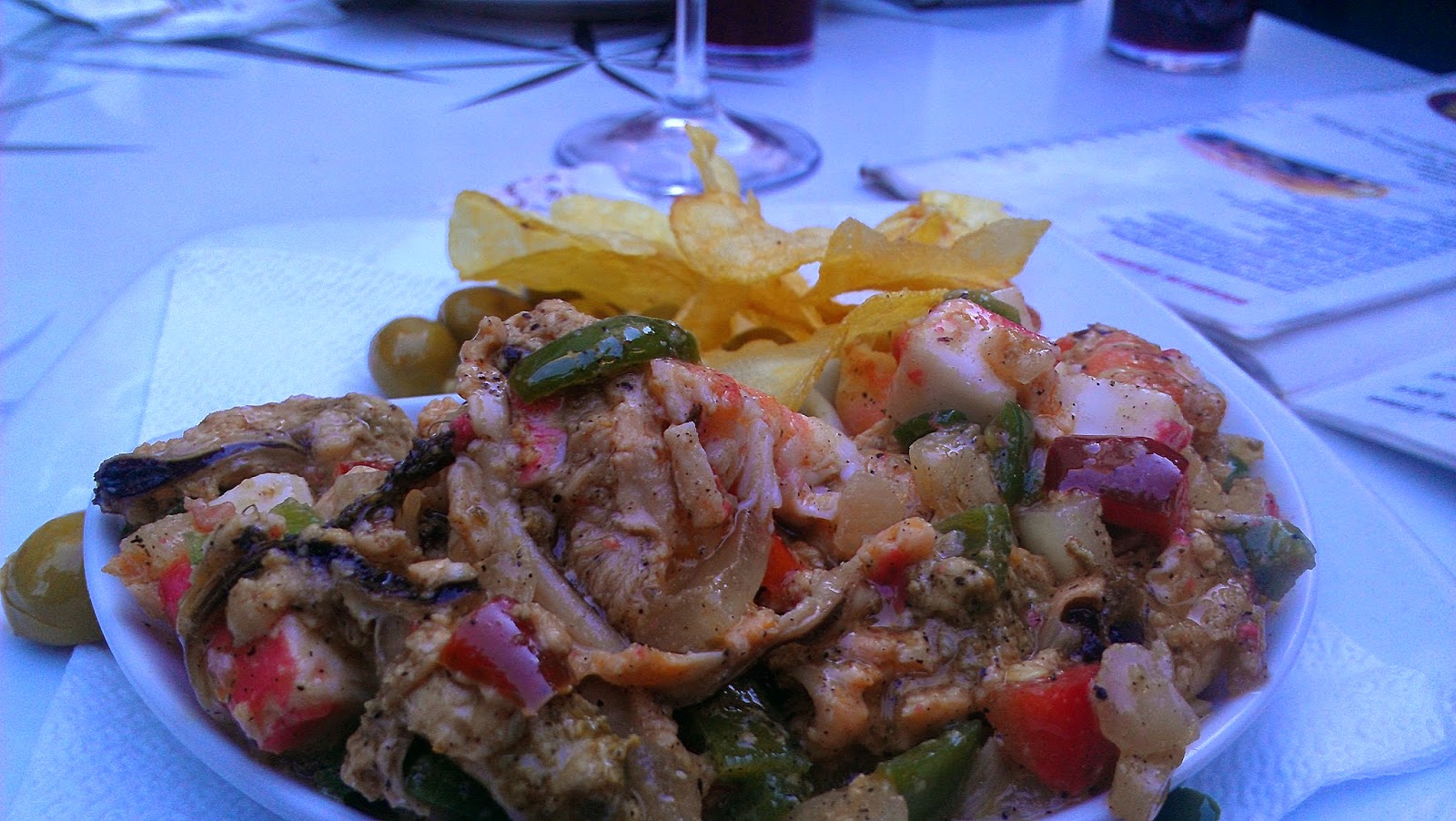.jpg)
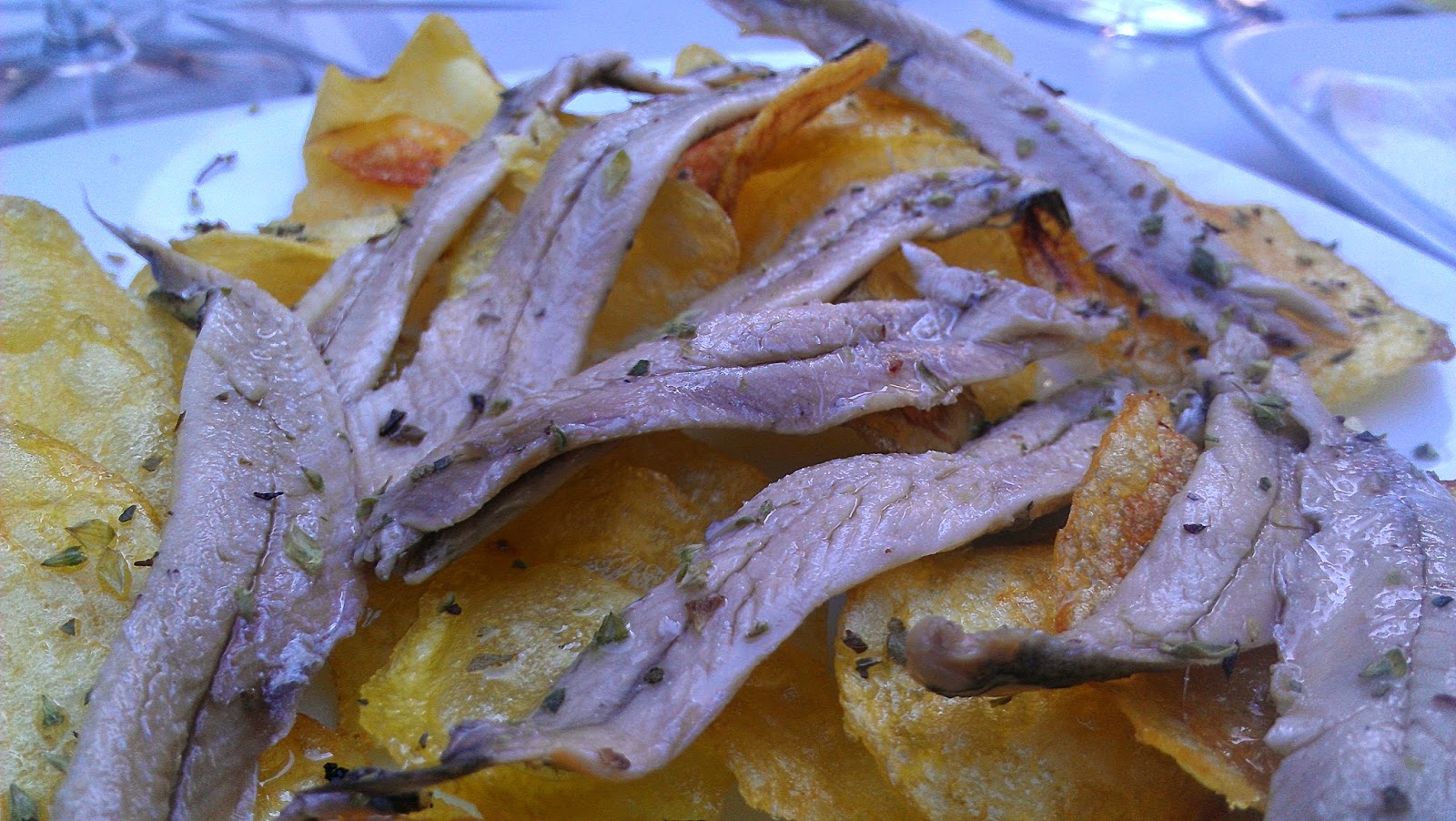.jpg)

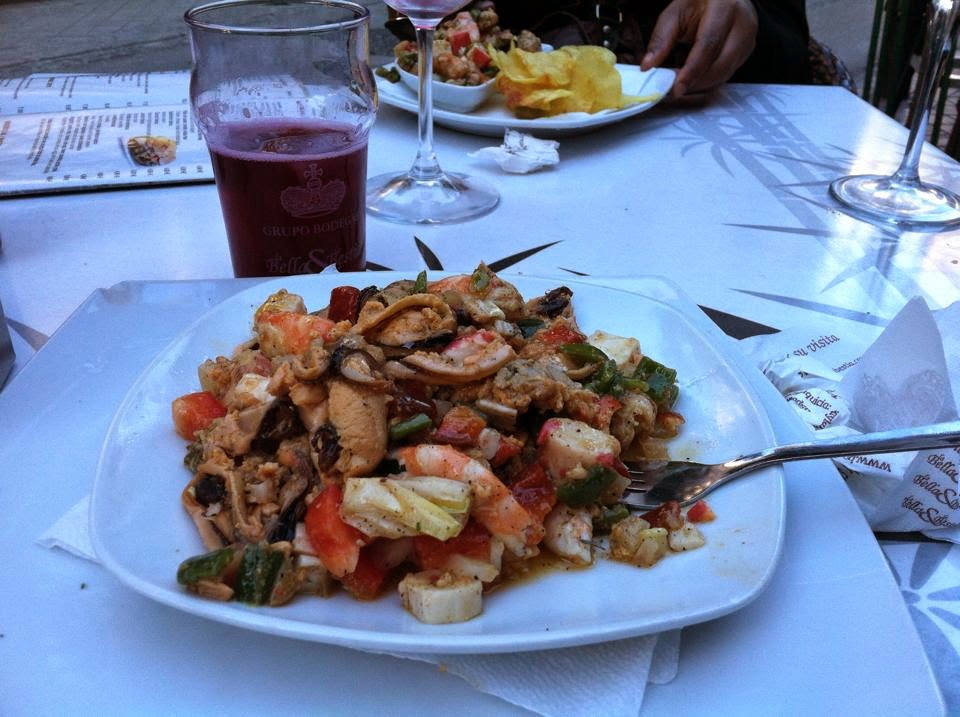.jpg)
.jpg)
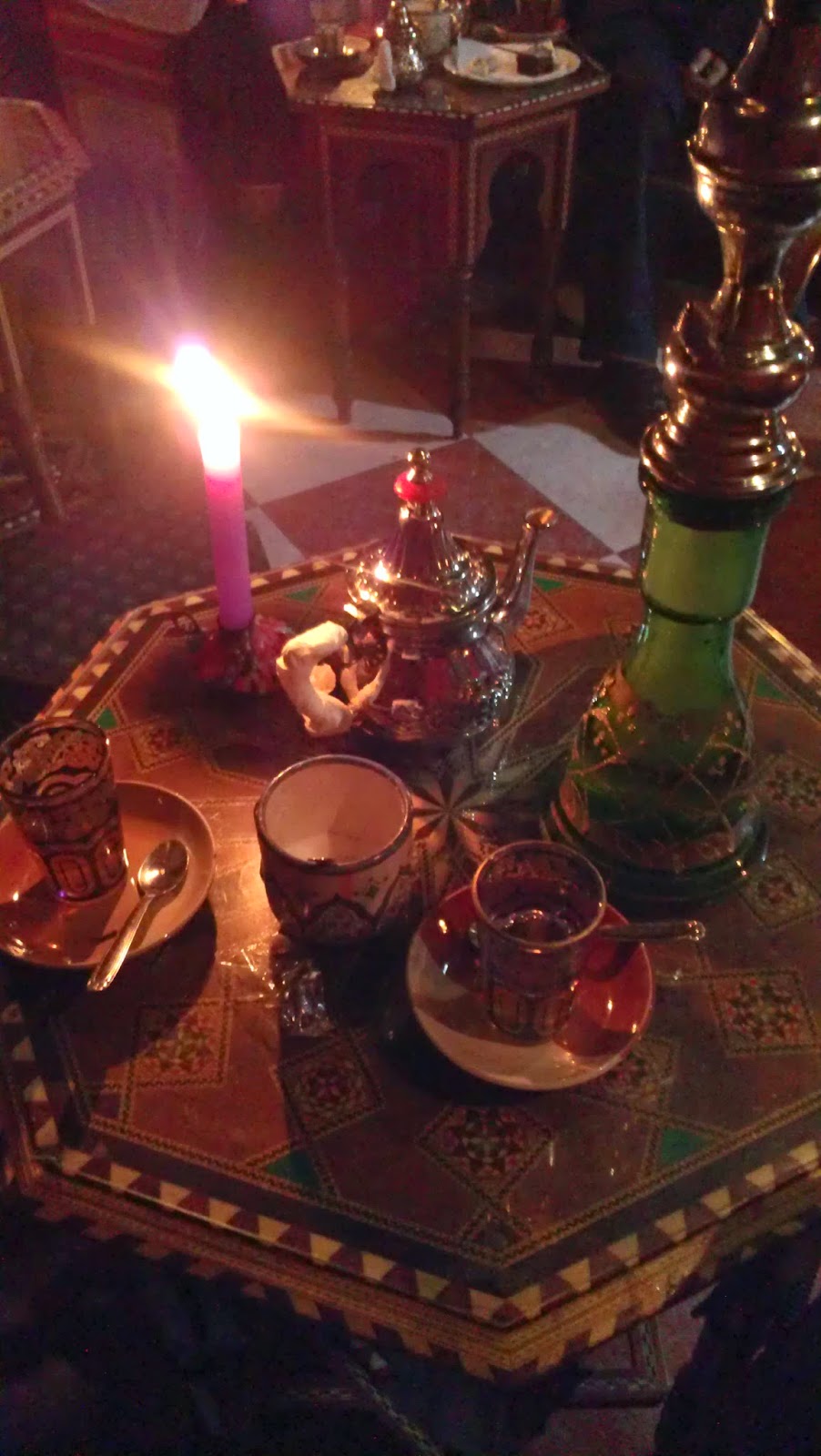.jpg)

.jpg)
.jpg)
.jpg)
.jpg)











